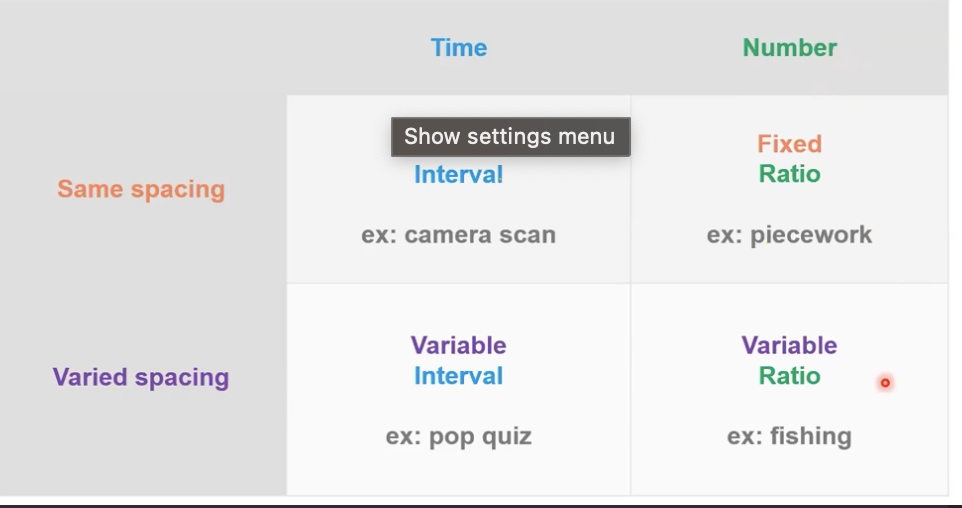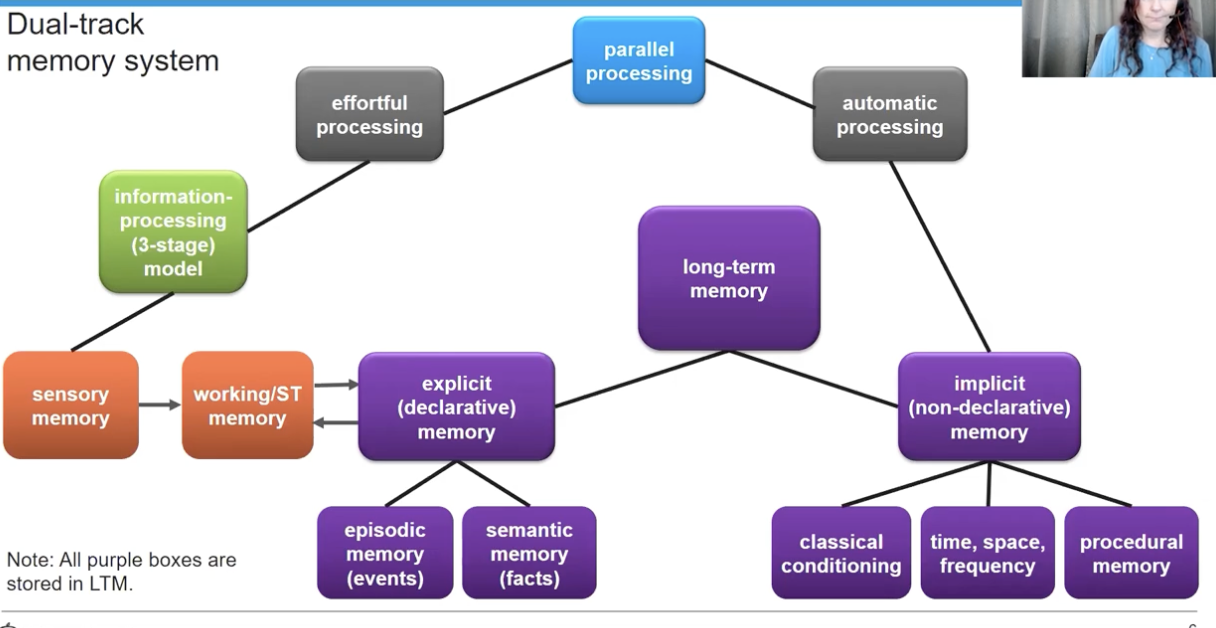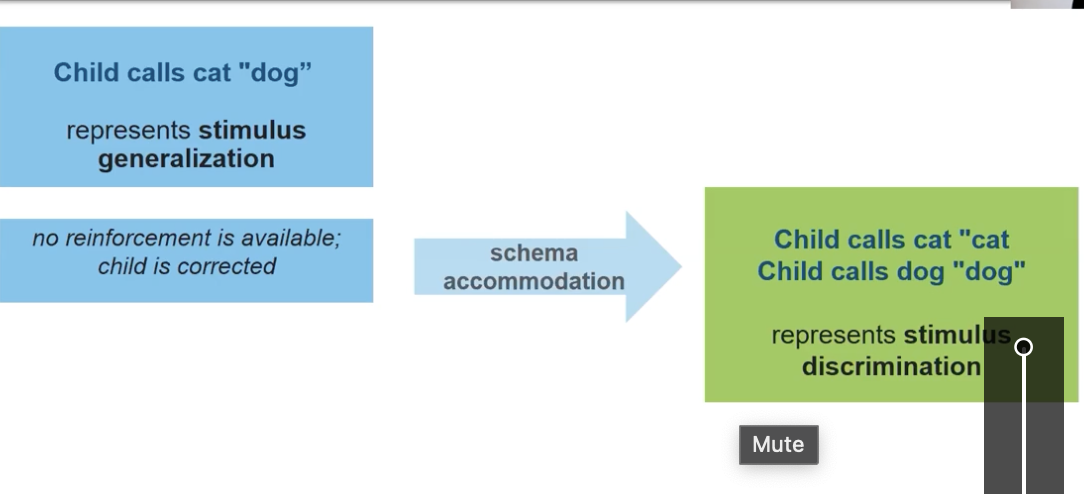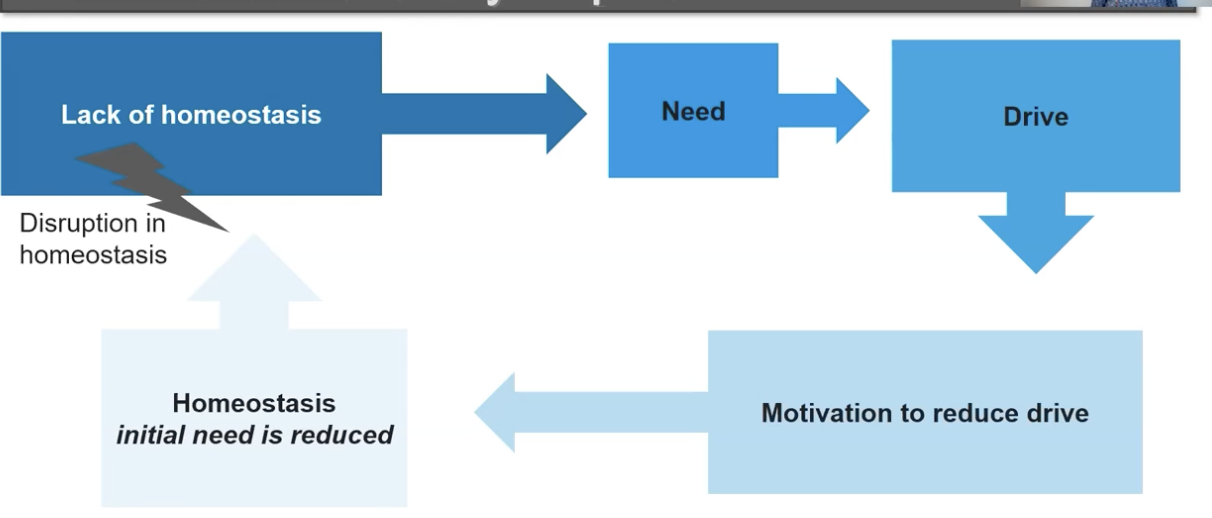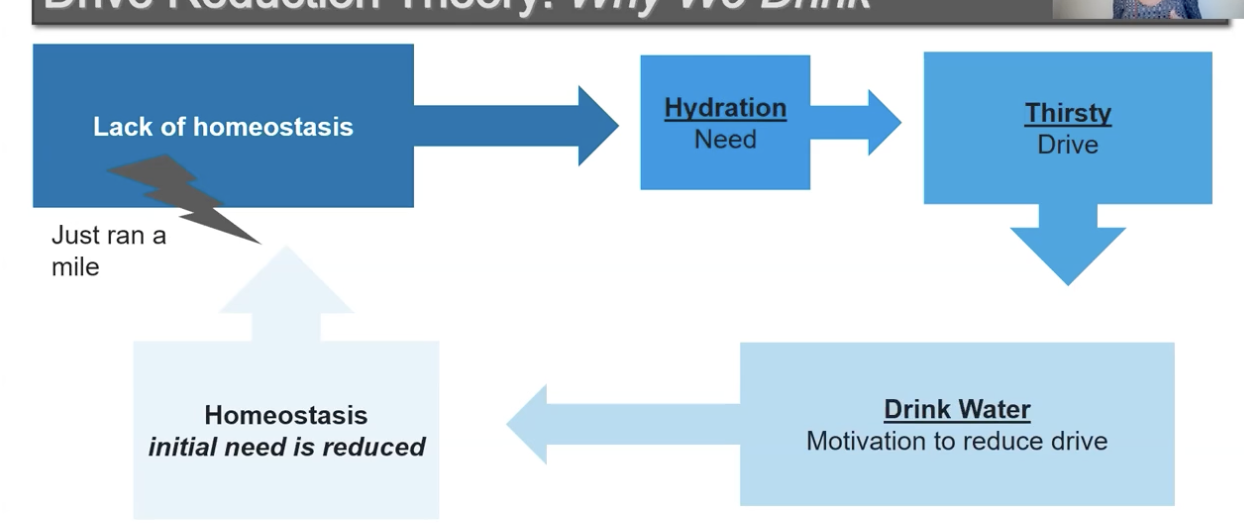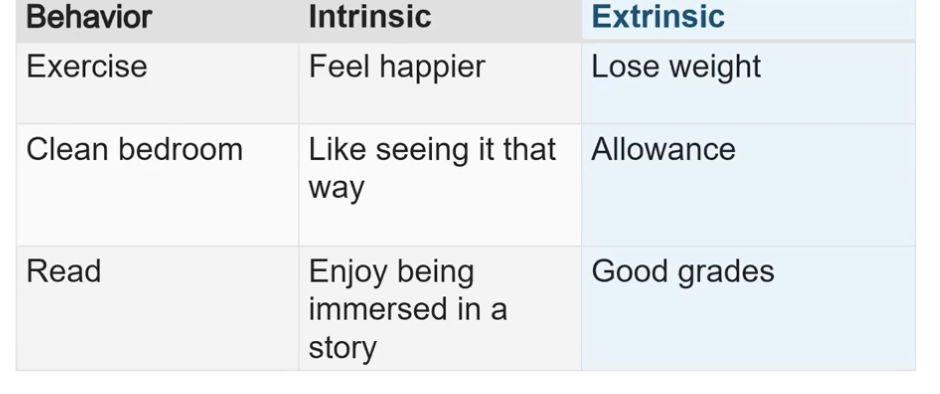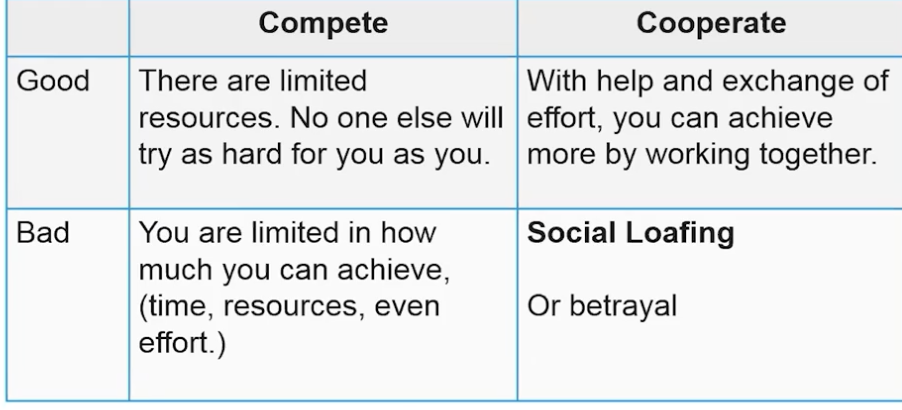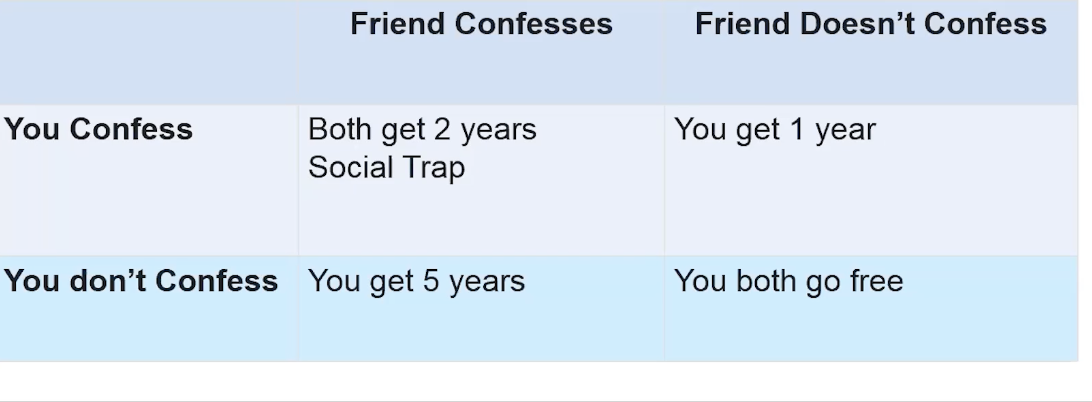AP Psych Cumulative Review
Unit 1
Structuralism - studying the mind by trying to look what it is made of
- Titchener, Wundt,
- introspection - asking a person to observe themselves perceive and think
Functionalism - studying what the mind does or its function
William James
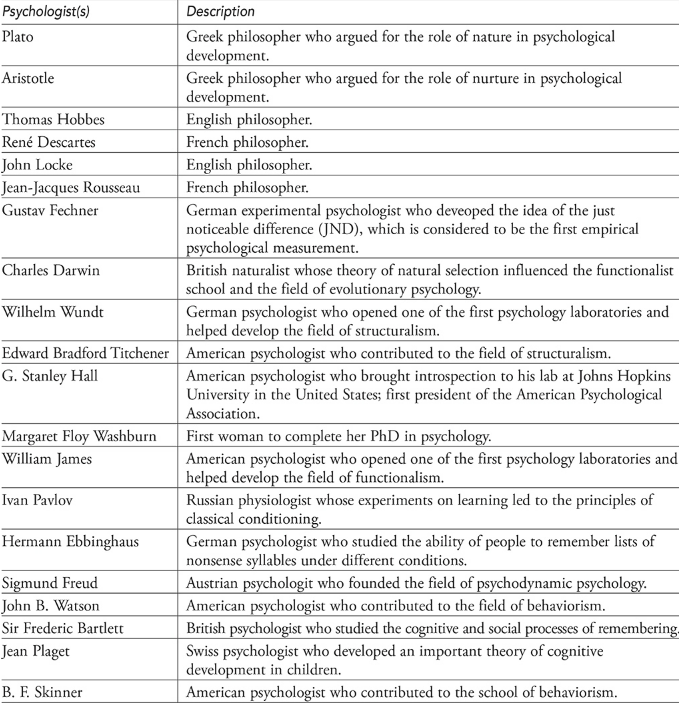
Psychodynamic approach
- oldest, lying on a couch, dream analysis
- unconscious
- Sigmund freud originally called psychoanalytic
- strength = it can be easy to say problem is due to unconscious thing can’t really be proven wrong
- limitation = no scientific way to study the unconscious mind
Behavior approach
- came out as rejection of psychodynamic
- counted, observes, behaviors and reflexes
- Ivan Pavlov founded classical conditioning based on reflexes
- strengths = reflexes/triggers can be measures
- limitation = creativity and thoughts can not be trained
- BF Skinner is known for operant conditioning
- reinforcement and punishments
- strengths = behavior can be measured and punishments/rewards have an effect
- limitation = sometimes behaviors, self less, have no explanation
Cognitive
focuses on thoughts
strength = flexibility allows for differences between people and complex thoughts and good treatments for mental illnesses
limitation - difficult to understand and study so scientific treatment has flaws because relying on own thoughts
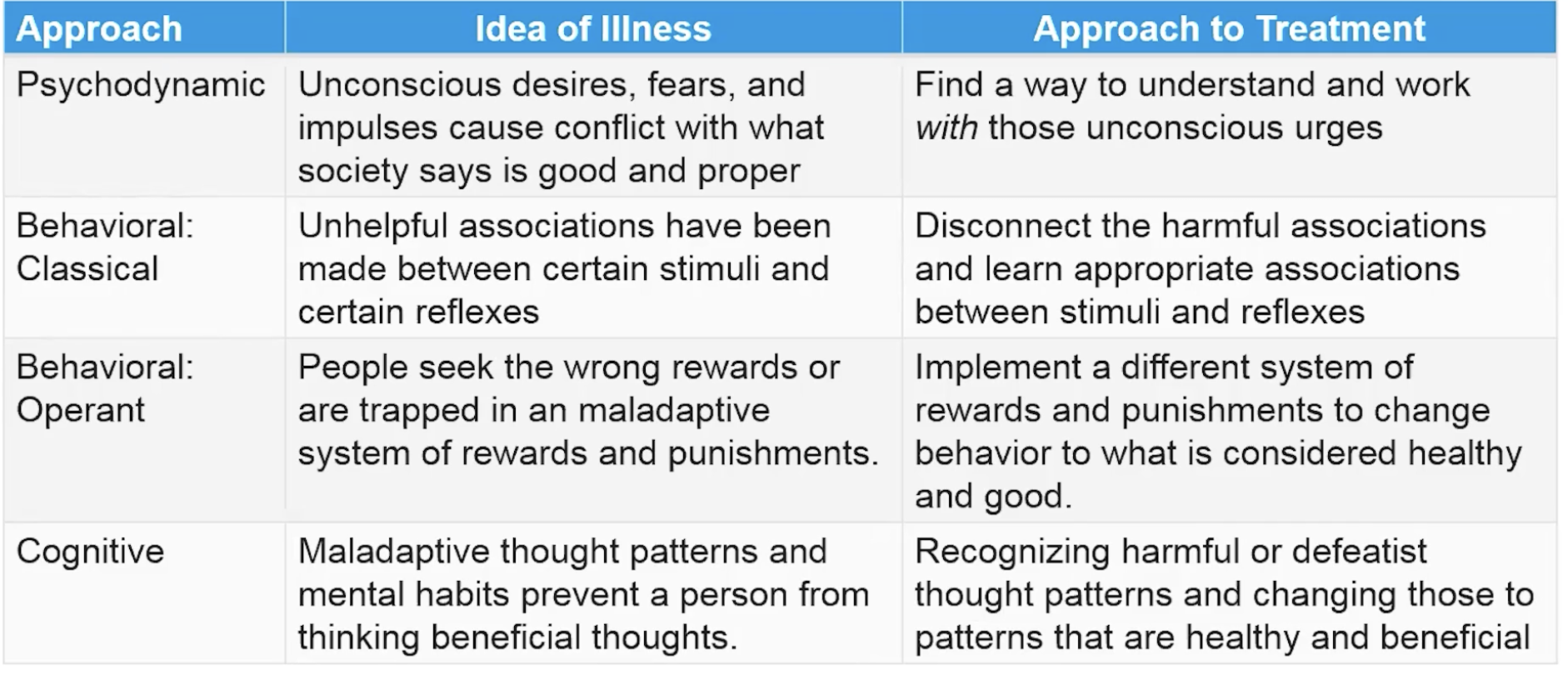
Biological
- mind is what the whole body and brain do
- strengths = scientific theory, we can measure things such as medicine effects
- limitation = very simple can’t explain complex things like love
Humanistic
- focuses on how people are unique and special
- optimistic and positive
- rejects pessimistic there is something wrong with you and that unconscious is in conflict or idea that people should be trained with rewards and punishments
- strength = positive, believes in growth, encourages difference
- limitations = how do you measure it
Sociocultural
- family, neighborhood, culture, society
- influences that make you, you
- strengths = can be measured, based on social media, comparing groups or taking averages
- limitations = difficult to apply to individual culture is hard to measure

Research methods
Survey - gather data about what people think and done
- strength = large amounts of data quickly, easily, anonymity, and process data
- weakness = paticpants can lie, misunderstand, and wording effect
Case study - deep data specific individual or group
- strength = details, chronological data, different views of subject
- weakness = time consuming, money, no causality
Naturalistic observation - go to people’s environments and observe
- strength = authentic data, no reaction bc not aware of watching, allow for real
- weakness = ethical concerns, lack control descriptions not explanations
Cross Sectional - compare different groups at 1 time in the moment no history
Longitudinal - follows 1 group over long time risk of inability for generalization
Experimental Method
- only way to find causal relationship
- independent variable and dependent
- hypothesis is prediction
- placebo effect, variable control
- experiment and control group
- random sampling, representative, random assignment
- less confounding variable with control
- participant bias = blind procedure and double blind researcher bias gone too
- hawthorne effect - no control group, sample size small, subjects change, research and participant bias
Statiscal Analysis
- interpret, organize, summarize ans analysize data
- descriptiive stats - organize describe data with charts and graphs
- inferesntial statistics - predict and make generalizations
- central tendency - mode, median, means
- variation - range and standard deviation
- frequency distribution - normal, positive(left skew), and negative (right skew)
- correlation coefficient -1.0-+1.0 weak = 0 strong = -1, +1
- statistical significance - p-value
Ethical
- APA ethical code with IRB
- studies are benefical and no harm
- studies have positive atmosphere, built on trusts accountable
- engage in trust and transparents
- prevent unjust practices and aware biases and be expert
- respect for people dignitiy and rights informed consent and privacy
Unit 2
Evolutionary approach - instincts
Heredity and Environment interaction aka Nature and Nurture interaction
^^Reciprocal determinism^^ - environment affects person and person reaction influences the environment
- ex: baby temperament nature and parenting styles affecting each other
^^Epigenetics^^ - environmental pressures can turn on/off the gene
- can cause process and behaviors and can be passed onto the next generation
^^Polygenic^^ - behavior/trait cause by many gene
^^Diathesis^^ - related to psych disorders a genetic predisposition with an environmental trigger
^^Maturationism^^ - related to development children following same pattern genetic but environment influence when they do
^^Plasticity^^ - brain change and arranges itself on the cellular level in response to environment
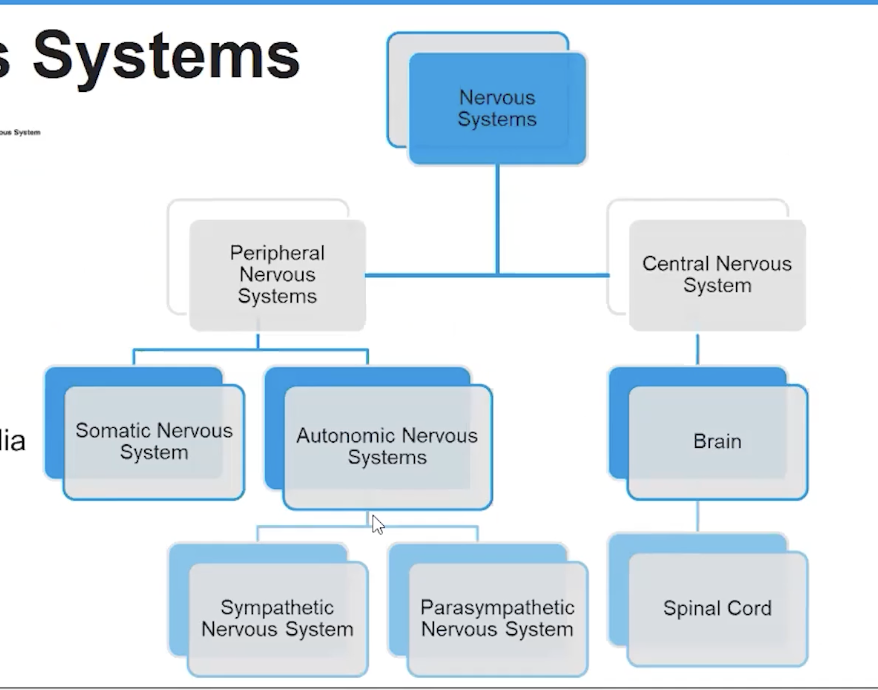
Endocrine System
main purpose to allow for communication
idea that glands use hormones to talk to other parts of body
ex: adrenal glands send adrenaline through bloodstream to body in emergency
- trigger by hypothalamus
intertwined with nervous system and other body systems
hypothalamus is key to primitive urges like fear, hunger, anger, sexual desire
^^Hypothalamic-pituitary-adrenal axis^^
- hypothalamus control the pituitary gland and gland is central communication center for all glands
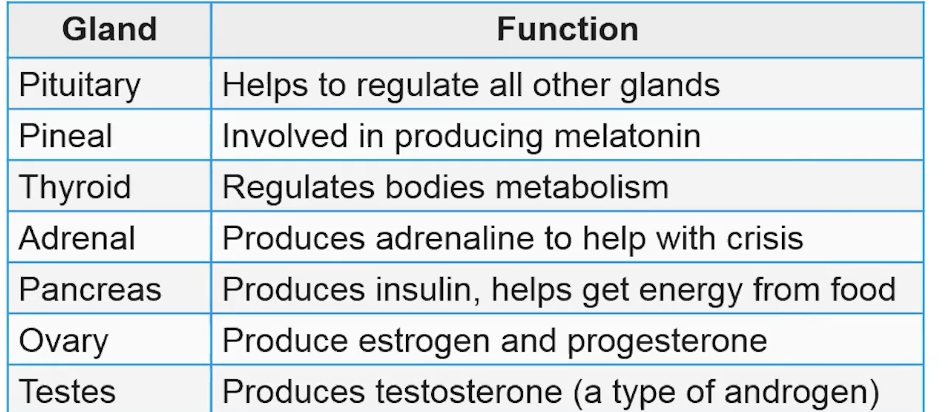
Endocrine and Nervous system communication
- hormones talk to glands and neurotransmitters talk to neurons
- hormones fit into neuron receptor sites and neurotransmitters fit into gland receptor sites
endocrine system and brain is feedback loop
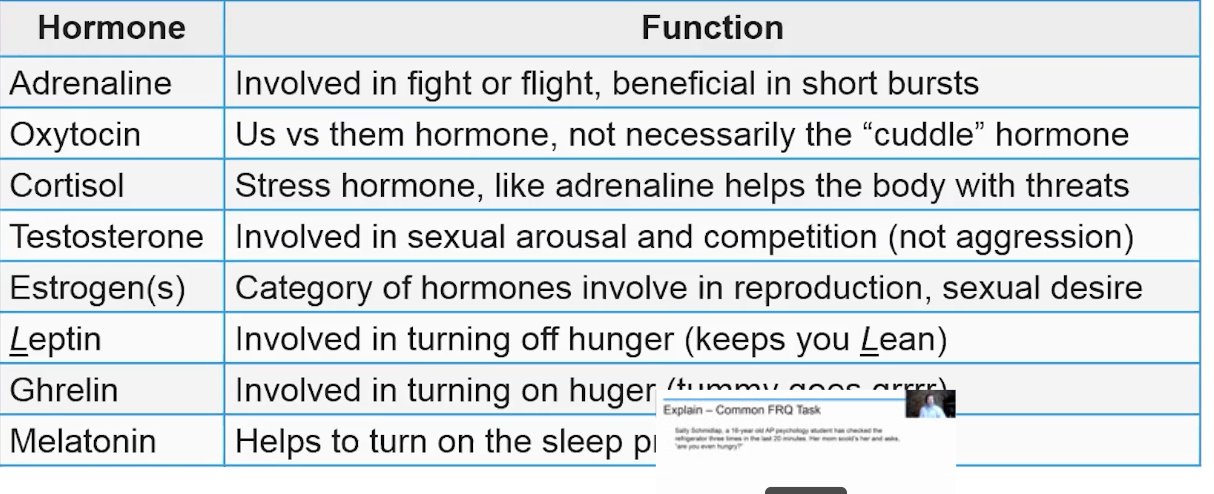
Nervous System
Central nervous system consist of brain and spinal cord
- organizes movement, create thoughts, form emotions, produce behaviors
Brain communicates and coordinates actions in body
- 3 pounds, blood carry nutrients and oxygen, skull, 3 layers of membrane, brain fluid is shock absorptation
Spinal cord transmit message from brain to muscle/glands
- consists of columns of nerves, protected by vertebrae, spinal reflex is simple automatic responses
Peripheral nervous system consist of somatic and autonomic nervous systems and transmit info to brain and body aka carry out orders from CNS
^^Somatic nervous system^^ works with sensory nerves work with voluntary movement
- pain, touch, movement, temperature
^^Autonomic nervous system^^ is involuntary system and control everything automatic
- breathing, heart rate, digestion
- 2 divisions
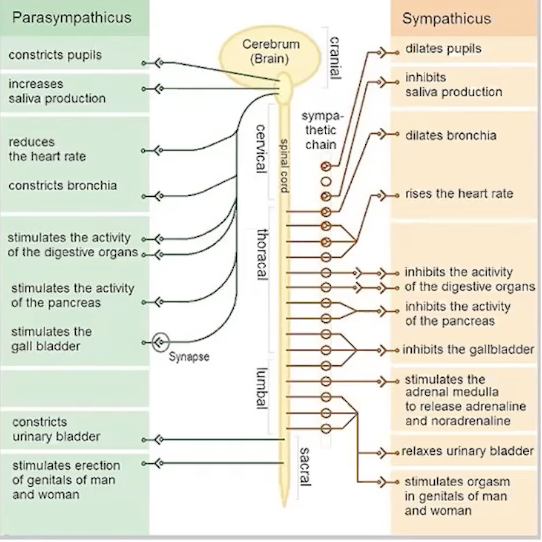
^^Parasympathetic nervous system^^ calms you down and default allows one to relax after emergency and your need comes back to awareness
^^Sympathetic nervous system^^ is emergency response and responds to situations that require alertness and forget any needs
Neural Firing
Glial cells job to protect and provide nutrients to neurons, most abundant cell, do not assist in info process
- 1 glial neuron schwann cell forms myelin sheath
Neurons
several ^^dendrites^^ which receive chemcial information and are short with branches
^^soma^^ called cell body which contains the nucleus and other structures to maintain neuron health
^^axon^^ long bundles of fibers carrying info away and spinal cord longest
^^myelin sheath^^ is fatty insulating cover of axon
^^nodes of ranvier^^ are gaps that promote action potential
^^axon terminal^^ last part of axon where neurotransmitters are stored
^^synapse^^ is space between axon terminals and next dendrites
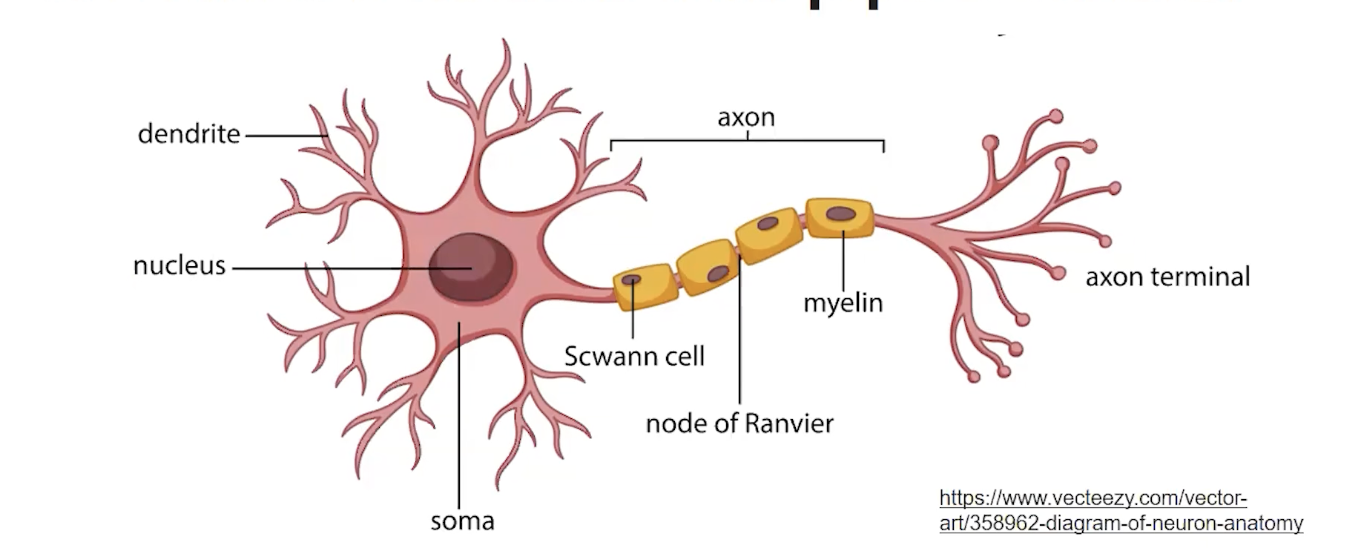
^^Sensory neuron^^ called afferent neuron receives info from sensory receptors through body and send to brain (sensory neuron approach brain bc afferent)
^^Motor neuron^^ efferent neuron send info from brain to body (motor neuron exits the brain bc efferent)
^^Mirror neuron^^ are activated when we watch others complete an active like yawning and these are in humans and non humans
^^Neural transmission^^ - sending of info to 1 neuron to another
Neural Impulse cycle
- environment outside the neuron contains ^^Potassium^^ positive
- inside the axon ^^sodium^^ negative ion charge
- ^^Resting potential^^ - state where more positive ions on the outside of neuron than inside neuron
- ^^permeability^^ - a process where positive and negative come together
- ^^Action potential^^ - neuron fires impulse because positive sweep down the axon aka firing threshold
- ^^all or none^^ - once electrical impulse reaches intensity level it will ALL fire
- ^^refractory period^^ - cell connot fire again but must wait to achieve intensity
- ^^re-uptake^^ - any excess neurotransmitters left in the synapse is recollected
- resting period again
Neurons governs every activity and behavior of human
^^Neurotransmitters^^ chemicals used to communicate to perform mental or physical activities
- message send to brain afferent and away from brain efferent
- stored in sacs in axon terminals
- 2 types
- ^^excitatory^^ - stimulate firing of messages
- ^^inhibitory^^ - slow down firing or stop message
^^Acetylcholine^^ - enables muscle actions (spinal cord and skeletal muscles) learning, memory
- deteriorate leads to alzherimer
^^Dopamine^^ - influences movement, learning, attention, and emotion
- similar nature to cocaine
- oversupply = schizophrenia
- undersupply = tremors and decreased mobility
^^Serotonin^^ - affects hunger, mood arousal, and sleep
- similar to LSD and Ecstasy
- undersupply = depression
- used to treat anxiety
- antidepressant drug increase levels
^^Endorphins^^ - linked to pain control and pleasure during great bodily stress such as accident
- associated with disorder like OCD
- make you feel good
^^Epinephrine^^ - associated with energy and the sympathetic nervous system
- helps responds to high emotional situations
- same chemical as adrenaline
- connected to forming memories
- related to heart
^^Norepinephrine^^ - associated with sympathetic nervous system and increase alertness, blood pressure, and heart rates
- reduce glucose to support flight-fight response
- related to blood vessels
^^Glutamate^^ - major excitatory involves in memory
- oversupply = migraine and seizures
- getting us to go
- can overstimulate brain
^^GABA^^ - GET A BREAK ADJUSTMENT major inhibitory
- undersupply = seizures, tremors, insomnia
- slow down
Drug effects
^^Excitation^^ must be met to reach axon potential and send message across synaptic gap synaptic vesicles release neurotransmitter from axon terminals Neurotransmitters fit the postsynaptic receptor site like a lock and key
^^Agonist^^ - a drug or chemical agents that binds to receptor and mimics a response as what neurotransmitter would have done
- produces MORE and creates enhanced effect
- ex: opioids and very addictive
- ex: L-dopa mimics dopamine stops tremors
^^Antagonist^^ - drug or chemical agent fights against what the neurotransmitter is trying to do by blocking the neurotransmitter from being release by terminal or from binding to receptor site
- produces LESS and create no effect
- ex: Botox blocks AcH from axon terminal stopping muscles from contracting
- ex: alcohol inhibits glutamate blocks release
^^Reuptake^^ - process of reuptaking neurotransmitters
^^Reuptake inhibitor^^ - drug or chemical that neurotransmitter is stopped from being absorbed and sits in the synapse
- produces more of neurotransmitter at the synapse site for next neuron to get
- producing an enhanced effect
- ex: SSRis like antidepressants/antianxiety meds to regulate moods
Brain structures
Brain regions: Hindbrain, Midbrain, Forebrain
^^Hindbrain Structures^^
- ^^pons^^
- above medulla
- responsible for autonomic functions such as regulating sleep cycles, communicating between cerebellum and forebrain, bladder control
- ^^medulla oblongata^^
- base of brain and extension of brain stem
- keeps us alive
- controls autonomic function like respiration, regulating blood pressure
- ^^cerebellum^^
- sits at back and base of brain aka “little brain”
- balance, coordination, posture
- integral to implicit memory formation
- ^^reticular formation^^
- attention, arousal, consciousness, regulating sleep cycle w/ pons
- retic tic tic itc snap to get attention
^^Midbrain structures^^
^^Limbic structures^^ - the emotional brain
- ^^thalamus^^
- sits above hypothalamus and in middle of brain
- sensory motor relay station
- route incoming sensory signals to forebrain to be interpreted
- thalamailus takes signals from eyes, ears, mouth to higher brain structure
- ^^hypothalamus^^
- helps us maintain homeostasis
- temperature, hunger, drives,
- works w pituitary glands w hormones and regulates fight/flight, sex drive, social bonding, reward pathways
- ^^amygdala^^
- emotional reactions fear and aggressions
- ^^hippocampus^^
- memory formation, learning, emotional regulation
^^Forebrain^^
- divided into 2 hemispheres and each side is broken down into 4 lobes
- most complex tasks
- cerebral cortex think of Flower POT
- ^^Frontal lobe^^
- ^^prefrontal^^ - center of judgement, foresight, thinking, plan, last part of brain to develop
- ^^motor cortex^^ - strip right half or cortex control left side and left half control right side allowing you to move
- association areas
- ^^broca area^^ - left hemisphere helps us decide which words to wear and helps us produce speech
- ^^Parietal^^
- ^^somatosensory cortex^^ - responsible for our largest sense organ skin
- association areas - network with all cerebral and midbrain
- ^^Occipital^^
- ^^primary visual cortex^^ - process what you see
- association areas - netowrk w rest of brain and help form longterm memories
- ^^Temporal^^
- ^^auditory cortex^^ - ability to hear and process
- ^^wernicke’s area^^ - left side working with broca and allows us to understand what i am saying take auditory code and interpret it
- association area
- on right side helps us recognize faces
Examining Brain
Case studies used to study brain damage, injury, and illness
- use info of changes in person behavior and use for future
Henry Molaison
- had seizures and removed hippocampus
- result in no forming new memories but remembered childhood
- this result in knowledge of understand hippocampus is needed to form and store long term new memory
Louis Victor Leborgne TAN
- suffered stroke and could only say word tan along with gesturing too
- right side of body became impaired
- damaged the broca left damaged broca’s aphasia - select words to speak
Phineas Gage
- railroad worker and damaged brain from gunpowder accident
- injured prefrontal cortex resulting in judgement, emotional regulation, and planning and unable to do these things
Split brain research
- ^^corpus callosum^^ - connects 2 hemisphere severing result in sides not communicating to each other
- used for people who had epilepsy
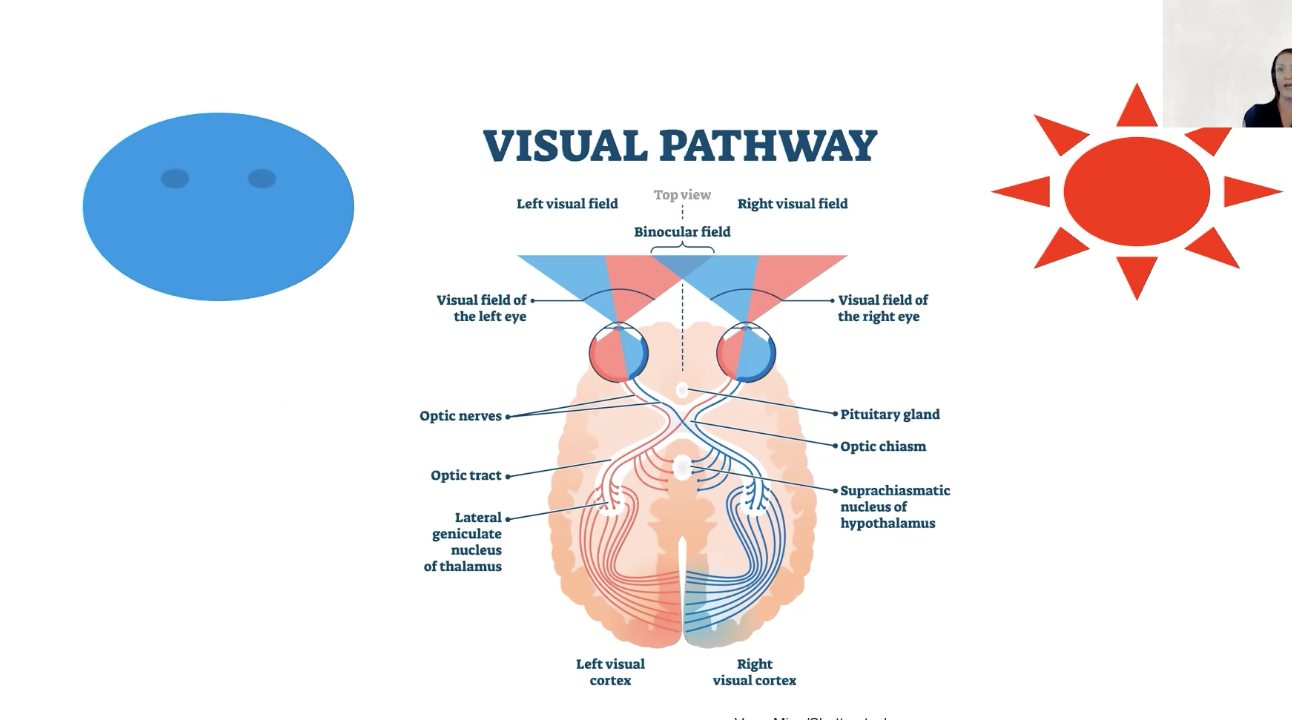
- so tested split brain patients because could only use left brain to interpret what right saw and right brain to interpret what left saw
- but only can do 1 thing since can not communicate
- right visual field
- control by left visual cortex
- could ^^say^^ what they see
- so left side is responsible for language broca and wernicke
- left also logic
- left visual field
- right visual cortex
- can ^^draw^^ what they see
- right = visual
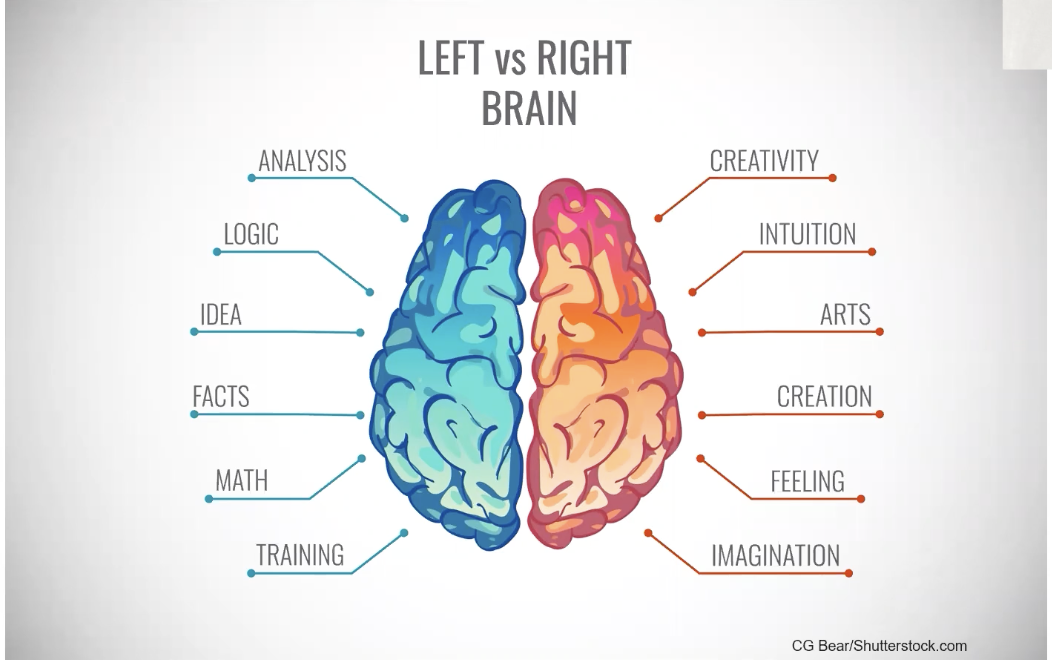
- no one is left or right brain we are whole brain
- left = language and logic
- right = spatial and facial recognition
- but need both to do everything
Tools for researching brain
- ^^EEG electroencephalogram^^
- electrodes are place on head
- detects electrical activity of neuron from them firing
- maps are brain waves based on electrode placement
- ^^PET positron emission tomography^^
- involves injecting individual with trace amount radioactive glucose
- picks up on activity and images it in the “hot spots” are neural activity
- as neurons fire consume glucose
- maps the brain activity and where it travels
- ^^MRI magnetic resonance imaging^^
- individual is in mri machine
- low level magnetic field
- pulse distorts magnetic fields and atom in body
- as atoms return mri able to produce detailed images of slices of the brain
- great info about anatomy and structure to compare health and unhealthy
- ^^fMRI functional magnetic resonance imaging^^
- person place in mri machine
- but records oxygen and blood flow
- so combination or MRI and PET
Psychoactive Drugs
A chemical substance used to alter one’s perceptions, moods, and consciousness
associated with physical and psychological dependence
^^Depressants^^
- drugs that reduce neural activity
- slows body functions depress body
- ex: sleeping pills, tranquilizers, alcohol (glutamate antagonist)
- people may feel relief of anxiety, tension, sleepy and possible slow breathing and weak pulse
- ex: opioids does function as depressant
^^Opioids^^
- from the poppy opiates
- synthetically produced opioids
- depressant effect and pain relief
- endorphin agonist
- ex: morphine, oxycodone, heroin, codeine
- provide feelings of euphoria but also depressants
^^Stimulants^^
- drugs excite neural activity
- speed up body function and stimulate body
- caffeine, nicotine, amphetamines, cocaine
- feelings more alert and excited
^^Hallucinogens^^
- also called psychedelics
- distorts perceptions
- evoke hallucinations sensations in the absence of sensory input
- LSD - lysergic and diethylamide
- Marijuana cannabis THC
Sleep and Dreams
Sleep in cycles
Sleep stages:
^^NREM 1^^ - 5-10 minutes, light sleep, alpha waves
^^NREM 2^^ - stable transitional stage 10-20 min, harder to awaken theta waves, falling deeper into sleep
^^NREM 3^^ - deepest sleep, body sleep/break, internal system slowed lowest, hardest to awaken, delta waves, growth hormone
- sleepwalking/talking and night terrors occurs
- gets shorter throughout the night
- essential for body
^^REM^^ - rapid eye movement, beta waves, internally very active, externally paralyzed, dream/nightmares, memory synthesis
same waves as when you are awake
essential for mind
get longer through the night
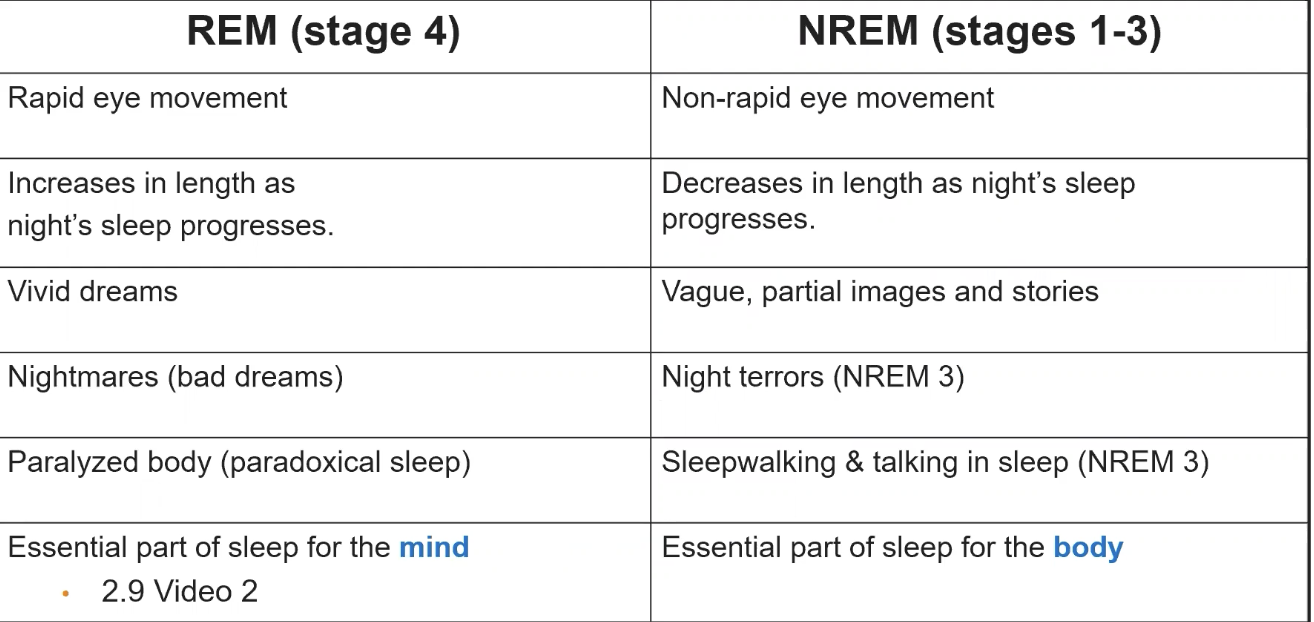
Stages involve different psychological and physical changes about 90 min to 2 hours
Transition down into deeper stages and then back up to active stages
Spend 1/3 of life sleeping
^^Restoration theory^^ - our body during the day uses up resources and sleep is necessary to restore these resources and reenergizes body
- sleep helps restore/repair muscles and brain tissue
- sleep supports growth
^^Adaptive theory^^ - base on evolutionary approach sleep emerged as animals evolved to preserve energy and protect us during the time of day when there is little for movement and removes us from considerable danger
- primed to sleep in dark and active during the light
- sleep protects us
- sleep helped animals to adapt to their environment
Cognitive and information processing theories - sleep helps us restore and rebuilding our memories of day’s experiences
- memory consolidation occurs during REM
- sleep deprived individuals struggle cognitively
- through REM deprivation studies
- ppl remember proir days events if slept well
- even rats remember better on sleep
Psychological theory
- Sigmund Freud original
- The interpretation of dreams
- proposed dream were road to unconscious filled with content that we avoid in conscious waking life
- manifest content - the stuff you remember and tell others
- latent content - hidden symbolic underlying ideas about dream
- modern psychological theories believe dream reveal stuff about our personalities
Biological and information processing theories
- dreams provide a way to sort out the day’s events and serve to consolidate our memories for storage
- activation-synthesis model
- REM helps to preserve and develop neural connections
- REM triggers neural activity in the cortex as memories are synthesized
- we make sense of random activity of the brain which often become our dreams
^^Insomnia^^ - the inability to fall asleep, stay asleep, or both
- most common
- 1/3 of adults
- adults need 7-9 and teen needs 8-10
- causes - stress(vicious cycle), irregular sleep schedule (to calm down and alert), pain/illness, diet medications
- deprives us of sleep and the cognitive and physical benefits sleep provides
- treatments - stress management , medications/melatonin, treatment of pain/illness, changing habits
Sleep apnea - cessation of breathing while sleeping
- happens repeatedly throughout night
- constantly wake up through night aware or not resulting in inability to get to the stages
- snorings, gasping, never getting fully rested
- 3 types
- obstructive - something is stuck in airway or throat
- central CNS - brain triggering the stopping of breathing
- complex - a mix of both
- causes vary but risk factors - weight, smoking, gender men, age, thick neck, narrow airway, nasal obstruction
- treatments - depends on cause, losing weight, C-PAP positive airflow, surgery to remove obstruction
Narcolepsy - falls into uncontrollable sleep attacks throughout day
- drowsiness, muscle paralysis (triggered by strong emotions,
- enters rem sleep
- causes- genetic
- treatment - medication, support
Unit 3
Basic Sensation and Perceptions
Gestalt Psychology (now cognitive theorists) 1900
- wertheimer, kohler, koffka, perls
- the whole is greater than the sum of its parts
- gestalt means placed, put together, pattern
Figure and Ground
- pragnanz = good figure
- law of good figure or law of simple
- the law holds that objects in the environment are seen in a way that makes them appear as simple as possible
- gestalt principles are based on how we simplify our world in similar ways
- organization of visual field into objects/figures that stand out from their surrounding/ground
- as info is coming in the visual system what should we notice or pay attention through continually searching
Gestalt grouping principles
- proximity
- way we organize/group things depending how close they are
- similarity
- objects appear to be alike/similar we group them together
- continuity
- mind naturally following and trace patterns
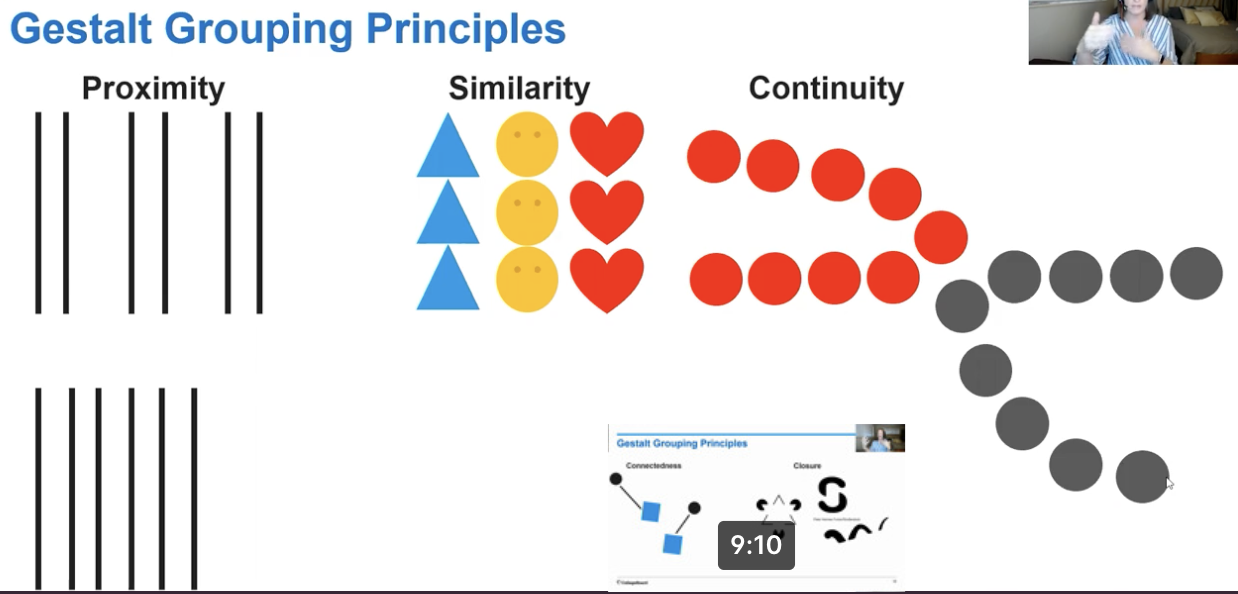
connectedness
- objects that move in same direction we see as a group
- closure
- see pieces and fill in gaps in mind making groups
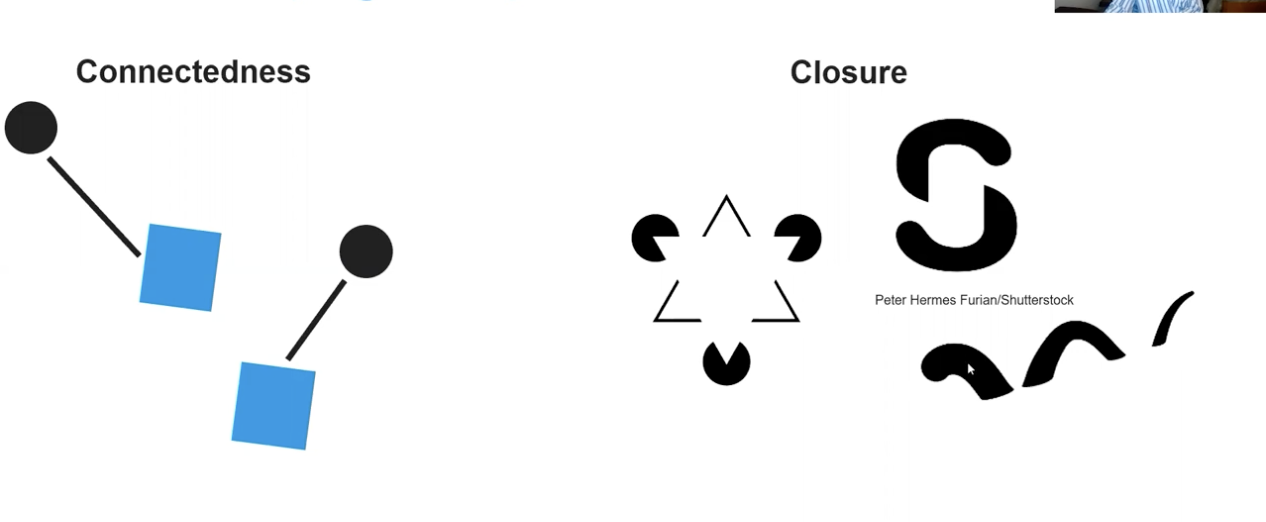
- see pieces and fill in gaps in mind making groups
Depth perception - the ability to perceive distance of objects in one’s visual field to perceive in three dimensions length, width, height
Binocular cues - requires 2 eyes and 2 types
- convergence
- neuromuscular cue
- 2 eyes move inwards for near objects
- 2 eyes straighten for further objects
- retinal disparity
- images from each eye different
- close object the LARGER the difference/disparity
- further the object the SMALLER the difference/disparity
Monocular cues - requires 1 eyes and many types
- relative size
- if object appears to be smaller to an object that should be similar size they are farther
- interposition
- images appear to be block are farther
- images not blocks are closer
- light and shadow
- things are hazy and shaded are farther
- things that cast bright light closer
- relative height
- objects that appear to be higher are farther
- objects that appear to be lower are closer
- texture gradient
- detail and texture lots and separated are closer
- detail and texture unclear and clumper together are farther
- linear perspective
- perception of depth based on parallel lines
- if they converge into the distance that is farther
- wider and more parallel looking are closer
Sensory transduction
- you are taking outside stimulus which activates sensory neuron and then transduces into a sensation
- taking something physical into a sensation
Absolute threshold
- smallest amount of energy that will produce a sensation about 50% of the time
- studies done showing about 50% you will
- feel bees wings on cheek
- light of candle in dark 30 miles away
- thresholds are low but not too low we should be able to focus
- children have lower absolute threshold
- think about the threshold needed to fire neurons
Sensory adaptation
- diminished sensory awareness due to constant stimulation above the threshold
- we are tuned to changes
Difference threshold
- smallest amount of change in a stimulus that will produce a change in sensation
- aka just noticeable difference
- measured by weber’s law
- physical proportion of change necessary before we sense the change
- ratio of actual change in the stimulus compared to the perceived change
Signal detection theory
- at what point are we able to detect a sensory signal or how much stimulation is needed to meet our absolute threshold for awareness
- used in radar detection in military
- used in medical field
- used in psychology
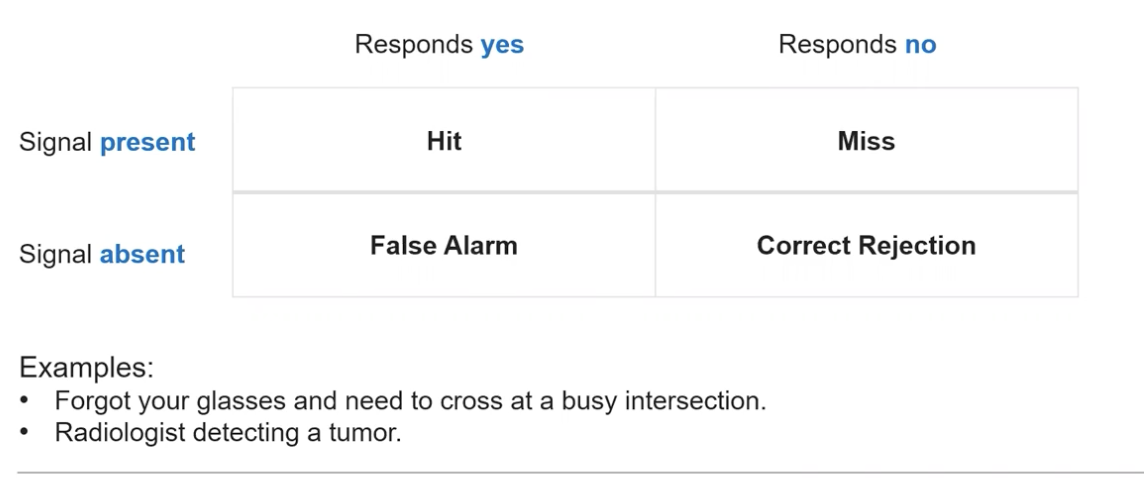
- this table helps determine if we see stimulus or not and if we act or not
Bottom-up
- ex: first we sense the stimulus and then we perceive and process the experience
Top-down
- first we perceive and process the experience so expectations, experience, culture, motivation, emotion
Perceptual set - our tendency to perceive some parts of sensory data and ignore others
- influences on perceptual set are the same as in top-down processing: expectation, experience, culture,
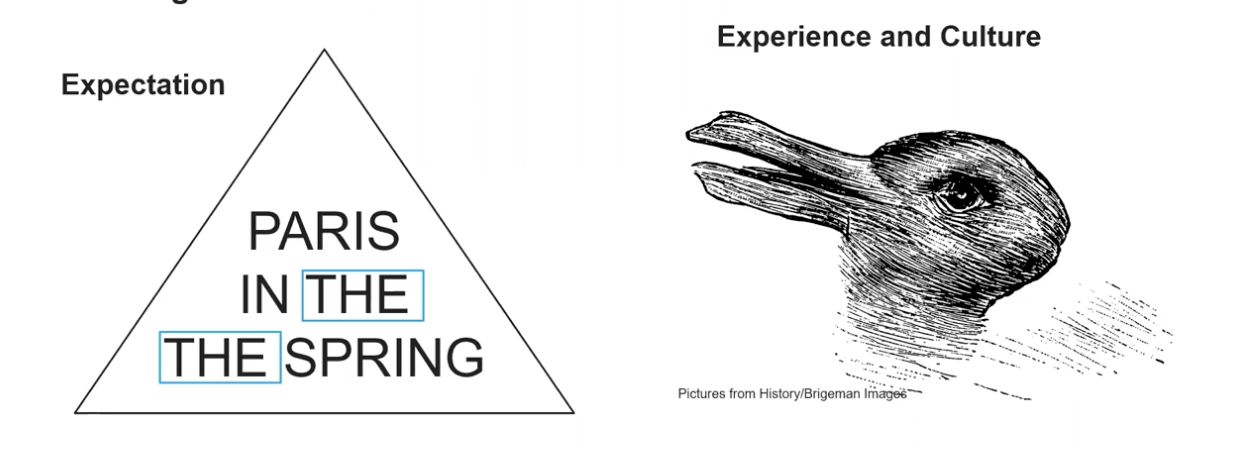
- emotion- angry people perceive hostility motivation - food deprivation study hungry think about food
Schemas - mental frameworks for organization our understanding of the world around us
- we build these from birth
- \
Visual
Bottom-up processing of eye
- Light waves enter through cornea to hit retine
- iris is muscle allows light in by expanding and contracting which surrounds pupil
- lens bends or reshape light to send to retina
- retina contains neurons for vision and fovea is hot spot and contains more cones than rods
- neurons fire and send it through the optic nerve to brain
- light stimulates retina rods and cones are very back of eyeball and these are connected to bipolar cell
- bipolar cells then send forward to ganglion cells and together they form optic nerve
- blind spots is where there are no rods or cones
Primary visual cortex
- in back of brain
- perceive in the occipital lobe in primary visual cortex
- and this responds to feature detectors: light and color, line, shape, angle, motion
In vision the stimuli for our receptor cells lining the retina are light waves
Light waves have 2 properties
- wavelength - distance between each wave
- determines hue
- short = purple/blue
- long = warm
- amplitude - height of wave
- determine intensity
2 stage theory of color vision
- Trichromatic theory - photoreceptors (cones) work in teams of 3 red, green, blue
- `first stage of color processing
- Young and Helmholtz
- combination of cones firing make up all colors in the visual spectrum
- strength of signal determines how the brain interprets the color
- as light hits retina cones are stimulated to create sensation of color
- opponent-process theory - as visual info is transferred from the photoreceptor (cones) to the ganglion cells some neurons are excited/turned on while others are inhibited/turned off
- 2nd stage of color processing
- explains phenomenon of after images
- both theory explain color vision
Color blindness - is the result of a lack of functioning photoreceptors for color. people who are color blind cannot distinuish excitatory from inhibitory signals or may have un responsive cones
- monochromat - no color, most rare, only black and white some grey
- dichromat - on/off switches do not work red/green or yellow/blue they cannot distinguish 2 color
- trichromat - all color is visual spectrum
- 1/10 men have it and it is a sex linked trait
Types of illusions
Physical - distortion of scale based on manipulation of monocular cues for depth perception
- muller lyer illusion
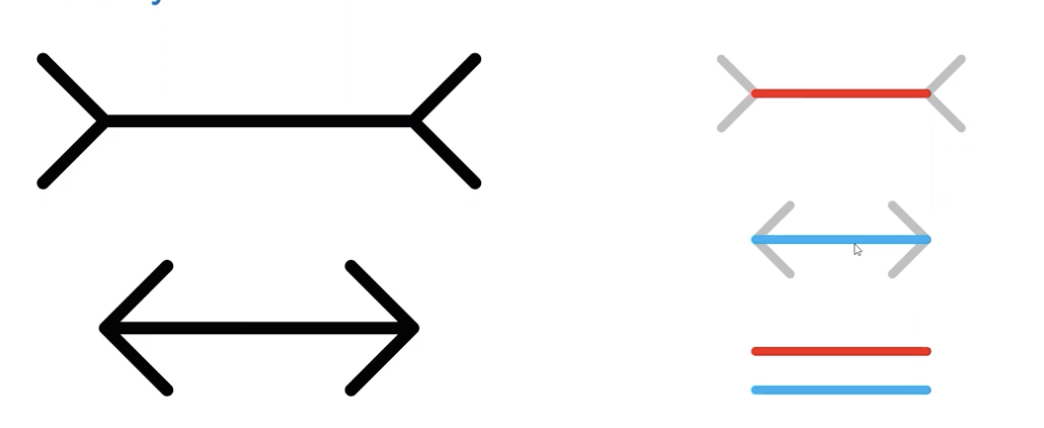
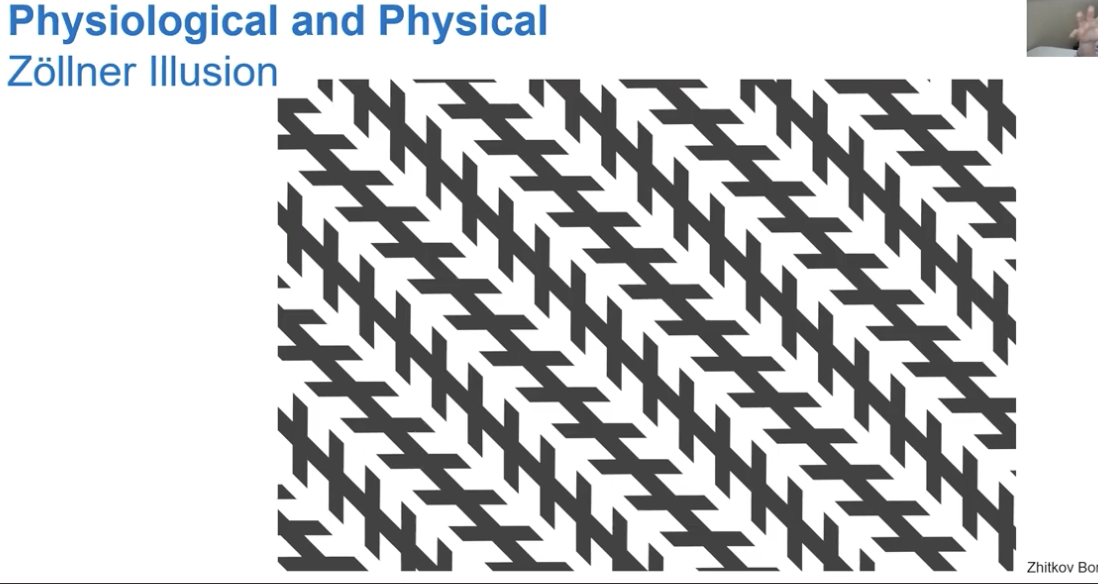
Physiological - visual system gets overstimulated excitement or fatigue of photoreceptors fatigue or stimulation of feature detectors in visual cortex
Cognitive - mismatch between what you perceive and what you sense top-down processing perceptual set context cues or manipulation of gestalt principle
- impossible figures MC Escher
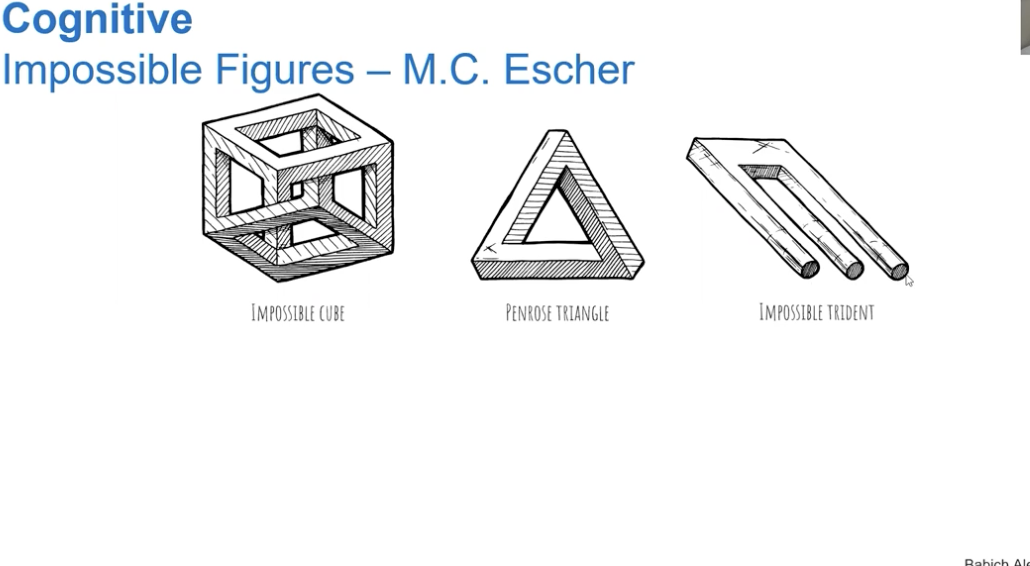
Auditory
Sound wave characteristics
- frequency - pitch how much the auditory cycles
- amplitude - loudness how high cycles
Ear is mechanical device
3 thing for hearing to occur: sound wave source, travel through medium, receiver
Outer ear - air as a medium of sounds transfer
- pinna part of ear easiest to see, external auditory canal,
- at end tympanic membrane and sounds collide with this and travel to middle ear
gather, concentrate, and amplify sound waves
Middle ear - solid as a medium of sound transfer
- three tiny bones
- Hammer (malleus) — attached to the eardrum.
- Anvil (incus) — in the middle of the chain of bones.
- Stirrup (stapes) — attached to the membrane-covered opening that connects the middle ear with the inner ear (oval window)
- these vibration passed on to inner ear
Inner ear - liquid as a medium of transfer
- cochlea - liquid filled
- cilia - cochlea hair cells start process of transduction
- auditory nerve and transduction
- allows us to interpret sound
Types of hearing loss
sensorineural hearing loss - impacts loudness, clarity, and range of sounds heard
- cochlear hair cells/cilia are damaged and auditory nerve damage
- affects both ears
- more common
- causes - aging, trauma, diseases
conductive hearing loss - sounds waves cannot progress normally through outer and/or middle ear
- out ear, ear drum, and bone in middle ear
- 1 or both ears
- causes - blockage, trauma to eardrum,
- hearing loss can be selective and depending on the degree and location of damage
- hearing aid might be beneficial
Other senses
Chemical senses: taste/gustation and smell/olfaction
They are chemical sense because molecules need to be dissolved for taste and molecules need to be evaporated in nose
Taste sensations: sweet, salty, sour, bitter, unami
- through sensory interaction gives each thing its own taste
Body sense: touch, pain, vestibular sense, kinesthetic sense
- sensory interaction within the body senses
- non-instrument navigation and extending proprioception
touch - pressure and temperature
- ex: petting a cat temperature and pressure sensation interact soft fur and warmth indicate cat
pain - can prevent further injury
- ex: hyposensitivity when people don’t feel pain and rely on other senses for survival
vestibular sense - bodily movement and balance
kinesthetic - awareness of where we are in space position and movement of skeletal joints
- ex: descending stair in dark without vision to aid use
sense of direction and space
sensory interaction may work with other senses as well as within a sense to create a perception
Unit 4
Learning is composed of: change in behavior and change results from experience, relatively permanent’
Key researchers in learning:
^^Albert Bandura^^ - observational learning we learn by watching a model and imitating them
^^Ivan Pavlov^^ - classical conditioning learning when one thing is associated with another
^^Robert Rescorla^^ - contingency in classical conditioning and stimulus salience certain things are more readily associated with a thing
^^Edward Tolman^^ - latent learning type of learning at 1 time but don’t display learning till later
^^John B. Watson^^ - behaviorism focus learning is on observable behavior and not about thinking radical behaviorist only look at observable behavior and not cognitive
^^John Garcia^^ - taste aversion more readily learned because we are biologically predisposed
Learning principles applied to different types of learning:
^^Insight learning^^ - make use of cognitive component of learning
^^Emotional learning^^ - what are feelings that make certain things more readily learned than others
^^Superstitious behavior^^ - associated a stimulus with a good luck charm
^^Learned helplessness^^ - even if we can get out of bad situation because previous behavior proved that we could not
Classical conditioning
Unconditioned stimulus first elicits an unconditioned response
- ex: watching an athlete run fast is exciting vs image of horse may elicit little/no excitement so neutral stimulus
Conditioned stimulus is associated with an unconditioned stimulus
- ex: a fast athlete is wearing horse on clothes so now horse is exciting
Conditioned response is elicit by the conditioned stimulus after pairing
- ex: horse is now eliciting excitement
Acquisitioned is now occurs when conditioned response is paired with conditioned stimulus
Extinction occurs when conditioned stimulus is no longer paired with the unconditioned stimulus
Spontaneous recovery - occurs when an extinguished response returns
Stimulus discrimination - occurs when responses differ with different stimuli
Stimulus generalization - occurs when responses are the same with different stimuli
Higher order learning/conditioning - occurs when we associate a conditioned stimulus with another conditioned stimulus
- ex: associate image of horse with cloud of dust and soon cloud of is now exciting
Classical conditioning vs operant conditioning
- differs when they occur happens before behavior vs happens after behavior
Classical conditioning vs observed learning
- classical conditioning associative learning and observational learning is simple imitating
Operant conditioning
Consequences motivates us to either avoid aversive stimuli or increase exposure to pleasant stimuli by changing the behavior that brought them about
E L Thorndike - figured out how do animals learn by putting cat in box with lever
- cats at first meow and did lots but eventually found the lever then last turn easily did it
- with food on outside
- law of effect behavior can be learned with a reward
B F Skinner - behaviorist perspective nurture side/environment affect you
- believe nothing but experience defines you
- elaborated on Thorndike’s law of effect
- explored different schedules of reinforcement
- also created Skinner box
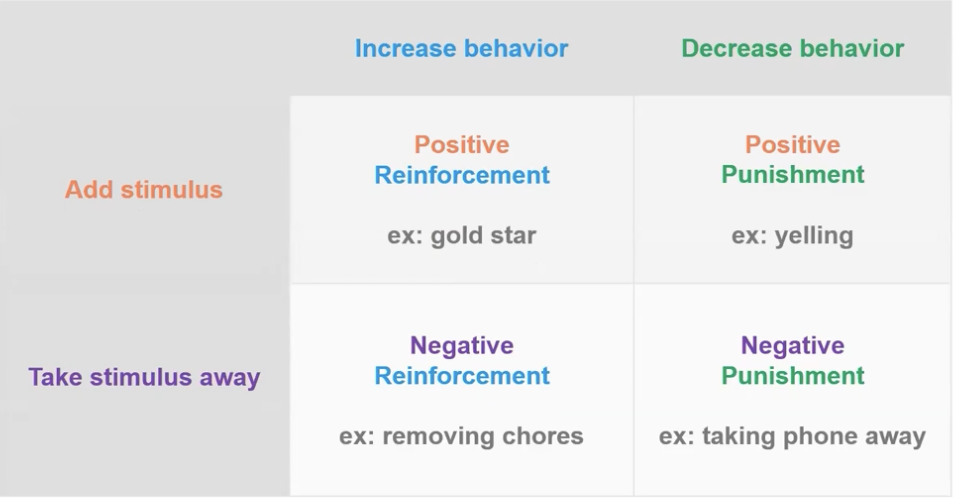
Types of motivation
- intrinsic motivation - desire to perform a behavior for its own sake
- extrinsic motivation - desire to perform a behavior for future rewards or to avoid threat of punishment
Overjustification effect is when extrinsic motivation has overtaken intrinsic motivation
Schedules of reinforcement
Stressors - are factors in our environment that cause us to have a biological response with increased hormones and brain activity
- emotion focused coping - attempts to avoid stressor but does not solve issues
- attends to emotional needs
- maladaptive ex: watch movie and not do homework
- adaptive ex: receive social support from friends
- problem-focused coping - associated with greater stress reduction and feeling more in control
- ex: completing school projects by breaking it into parts
Self-control - ability to delay gratification and control impulses
- can be depleted through use
External locus of control - outside factors that affect our lives
- believes outside factors control life like luck
- no ownership over outcomes
Internal locus of control - we direct our own fate and correlated with achievement and health
- we want to feel like we are in control
Biofeedback - use cognitive factors to influence physiological factors of stress
- feedback to teach us about subtle bodily response
- tension in forehead and feedback about blood pressure
- helps with tension headaches
Unit 5
System of memory
Memory - learning that persist over time
- information and experiences that are encoded, stored, and retrieved
Multistore model of memory - information moves through multiple stores
Atkinson & Shiffrin’s information-processing model - similar to sequential computer processing
- 3 stage model or 3 box model
- sensory
- short-term STM
- long-term LTM
Baddeley revised STM → working memory - where we process information actively
STM is like a shelf used temporarily working memory is like the workspace at your desk
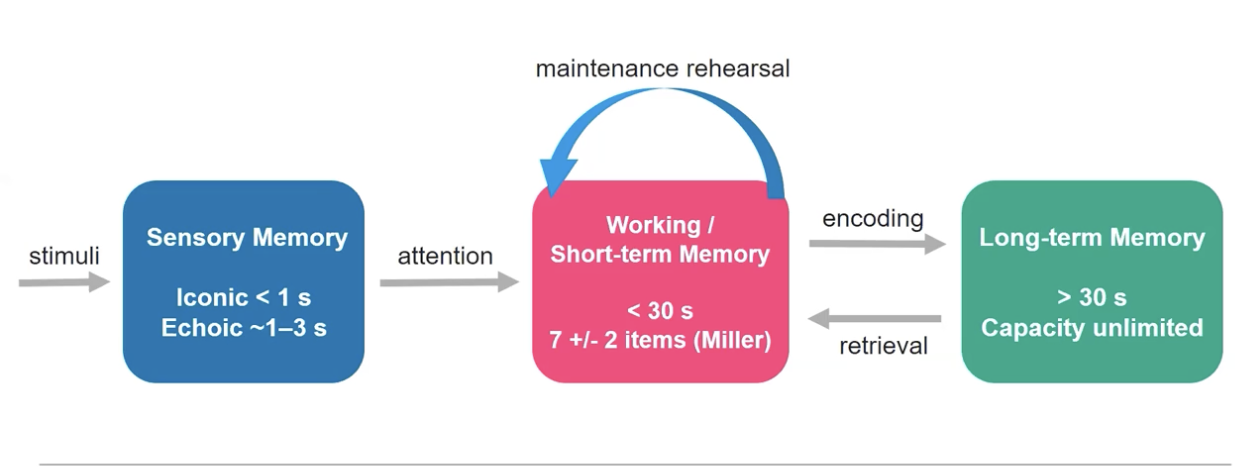
Sensory Memory
- Iconic visual < 1s
- Echoic sounds ~ 1-3s
Working/short-term memory
- < 30s
- and you can remember about 7 +/- 2 Miller
- maintenance rehearsal trying to remember something by repeating something
Long term memory
- \
30 secs so forever
- capacity unlimited
Types of encoding
- visual - encoding by visual elements like color font
- acoustic - encode by sound like rhyming
- semantic - encode by meaning like category word by belonging
Types of processing
- shallow processing - little elaboration with a focus on superficial and/or perceptual elements
- ex: encoding word by font
- deep processing - focus on the meaning with deeper elaboration
- ex: encoding a work by meaning and connecting it to previous learning/meaning
spacing effect
Massed practice - try to encode all at once ex: cramming
distributed practice - encode over multiple time periods the longer, the better, ex: daily review sessions
spacing effect - distributed practice → long-term retention vs massed practice
testing effect - retrieving info for assessments > restudying or rereading
order effects
serial position effect - the middle items are the least remembered
recency effect - the last items in a list remembered best immediately after presentation
- mostly bc still in working memory
primacy effect - the first items in a list are remembered best in the long-term memory
- due to encoding in LTM
organizing effects
chunking - clustering item into unite, especially of meaningful
- ex: number chunks in phone
mnemonics - memory devices, often using association or imagery
- ex: key-word methods, peg word
hierarchies - creating categories with subdivisions
Serial processing - only one process occurs at any given time one after another
- ex: information-processing 3 stage model
Parallel processing - multiple tracks of brain processing occurring at the same time
- ex: after walking and discussing your favorite book you remember the temperature time passed key points
- not the same as multitasking
Effortful processing - explicit declarative memory such as experiences and facts
- explained through information-processing 3 stage model
Automatic processing - implicit non declarative memories encoded unconsciously such as time, space, frequency
- includes procedural memory and classical conditioning
Dual-track memory system
Retrieval - getting information from long term memory
Recognition - identify previous learning and stable over time
- ex: multiple choice
Recall - pull out previous learning declines with age
- ex: giving a definition for a term
Relearning - improved retrieval with repeated learning
- studying for unit exam
Overlearning - practice after learning a skill to make it more resilient to forgetting
- ex: learning a certain move but then repeatedly doing it for an extra 30 min
Retrieval cues - serves as connection points to access a memory such as smells, sounds, or visual element
Priming - activation of memory associations sometimes unconsciously
- previous exposures may influence future thoughts/behaviors
- ex:n driving past vape shop sign and then seeing a pencil but thinking it is a vape pen
Context dependent memory - revisiting the location of an experience serves as a cure
- ex: you walk into kitchen to get tape and forget so leave and then see paper and remember needed tape
State-dependent memory - what we experience in one state could be remember better the next time we are in that state
- ex: mood-congruent memories - emotions serves as a cue you can often remember events better when in the same mood
Encoding forgetting - something was is our working memory but did not sufficiently link content into long term memory
Storage decay - where overtime memories decay
Retrieval failure - memory is still stored in long term memory but have trouble accessing it
- ex: tip-of-the tongue phenomenon
Storage decay
Ebbinghaus’ forgetting curve (1885) - memorized nonsense syllables and tried to see if he could recall
- ex: tgi omg wqs
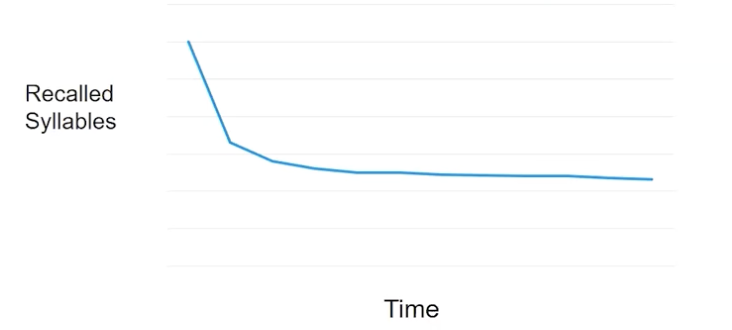
- steep drop-off of recall initially levels out
Proactive interference - forward-acting prior information gets in the way of learning new information
- ex: learn mandarin in elementary school and highschool you learn korean but sometimes say madrian
Retroactive interferences - backward acting new information gets in the way of recalling old information
- ex: now korean gets in the way of remember mandarin
Amnesia - temporary or permanent loss of memory
Retrograde amnesia - inability to remember past information or experiences and procedures remain intact
- ex: blow to head leading to forgetting recent events
Anterograde amnesia - inability to form new memories and still can learn new things but does not remember knowing that they learned it
- ex: HM who had hippocampus removed in seizure surgery
Source amnesia - attributing an experience to the wrong source
- ex: telling a joke to someone who told it to you last week
Ways to improve memory
- make it meaningful with links/associations
- distributed practice - spread out learning
- activate retrieval cues
- testing effect - quiz often on material
- chunking
- mnemonics
- sleep - brain can consolidate and study material at bedtime and no new ino interfering
Biology of memory
- changes happen at the cellular level in the brain when learning happens
Long-term potentiation - increased efficiency in the synapse when repeatedly stimulated
- neuron needs less activation
- more connections between neurons
- lasts from hours to weeks
Explicit memories - memories for experiences and facts
- associated with the hippocampus and frontal lobe
- hippocampus - sending information to the right place aka hub through which complex neural memory networks are made does not store memories
Implicit memory - memory for procedures, conditioning, timing
- cerebellum associated with classical conditioning
- ex: cringing at lightning before thunder reaches your ears
- basal ganglia in the deep brain associated with procedural motor skills
- ex: riding bike
Emotional memory - the limbic system is the center of emotion in the brain including the hippocampus and amygdala
Flashbulb memory - not immune to alterations
- usually very personal experience ex: first kiss
- shared flashbulb memories like 9/11
Thinking and problem solving
Thinking? where do answer come from?
Look at structures or function of thinking
- Structure of thinking Wilhelm Wundt? or MRI?
- function of thinking William James? or fMRI?
Concept - a cluster of cognitive raw material
- very difficult to have piece of cognitive info by itself and you will either forget it or will connect it to another piece of info
Prototypes - a great abstract example not a perfect one, but not a great one
- ex: golden retrieval
Exemplar - a great example from experience but experience is limited
- ex: think of golden retriever you met
Artificial concept - a perfect example very rare in real life
- ex: a circle in geometry
Informal reasoning - fast thinking
- brain is fast can think in 10ths of a sec but slow to evaluate many possibilities
- heuristics - shortcuts based on experience and work fast and efficient ex: find keys
- top-down processing - already having the gist of situation before having all the details ex: furniture store know it is chair
- schema - a set of ideas//concepts that can be used to view a problem ex: teacher think like teacher
- mental set - similar to schema it is a way of thinking that has worked before ex: keep working and it will pay off
- mental model - a way. of thinking about how thing interact based on assumptions and stereotypes ex: brick vs glass window
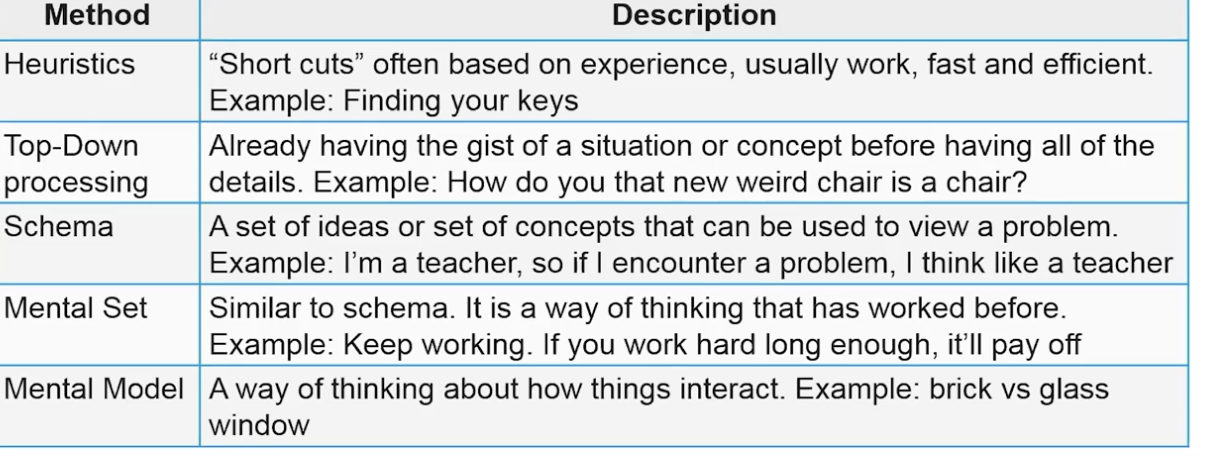
Formal reasoning - slow thinking
- it takes time to concentrate but allows us to be more sure and lower p value
- algorithm - step-by-step process ex: finding to lost keys by starting in one corner and move step by step
- bottom up processing - gathering as many bits of data as possible before making a conclusion ex: scientific method
- syllogism - using logic and may be difficult but skill can be improved ex: A=B B=C A and C???
- diagnosis - eliminating all of the wrong answers will leave you with the right answer
- artificial intelligence - similar to an algorithm facial recognition, auto complete, self driving cars use steps to process to find patterns
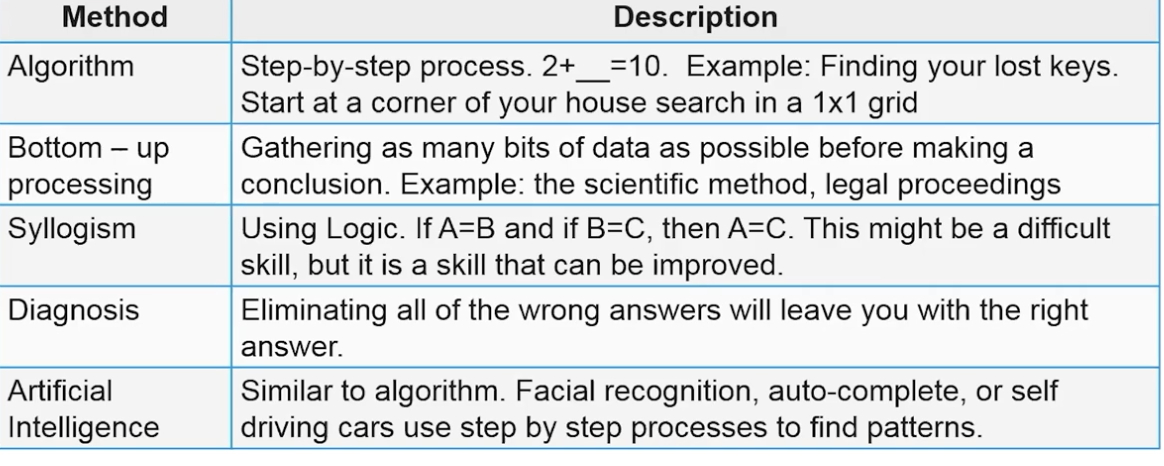
Heuristics biases - thinking shortcuts that can lead us to the wrong answer
- not always bad and useful
- it is like a process that leads to cognitive bias
Cognitive biases - the result of using imperfect thinking strategy
- these results can then be used to create event more wrong answers
- there are many cognitive biases
Abstract - differences between heuristics vs biases can be pretty abstract
Concrete - examples, explanation not definitions
- come up with own examples
Heuristics/biases and other thinking errors 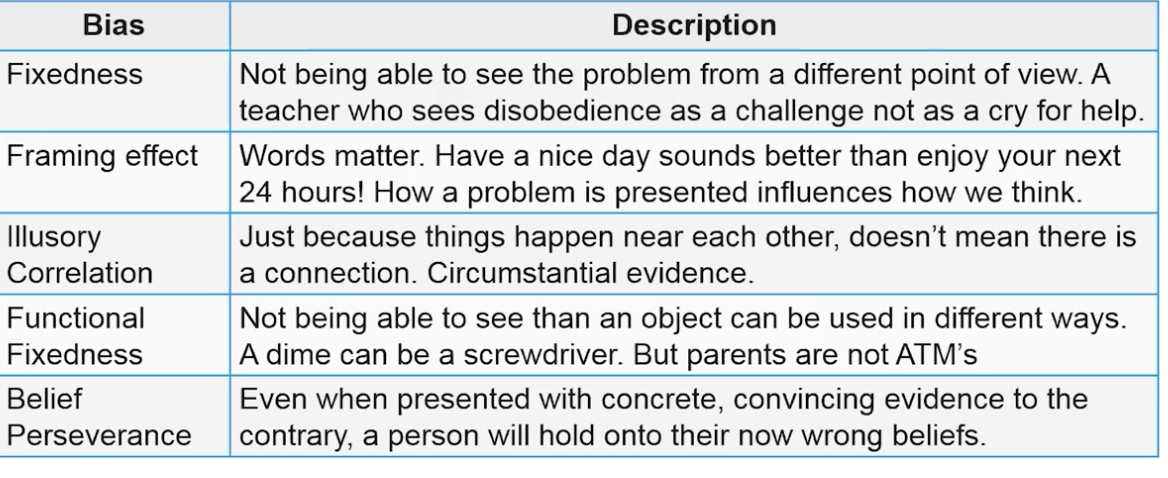
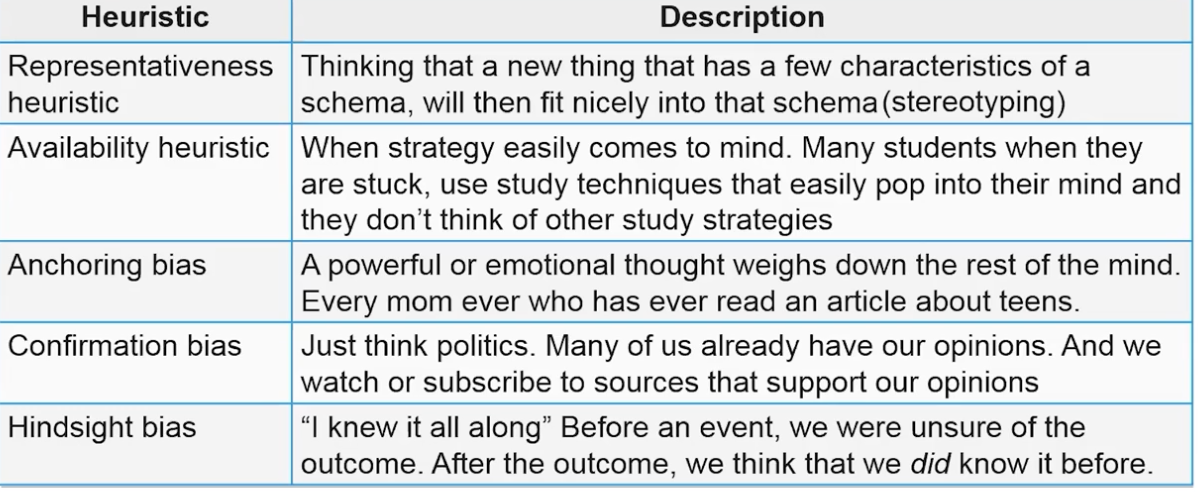
Intelligence
Intelligence it is difficult to define because so many different views of intelligence
- abstract definition - intelligence is the ability to think creatively and the ability to apply knowledge to new situations
- operationalized - traditional tests were verbal tests and easy to grade and compare
- reductionism - is the belief that human behaviour can be explained by breaking it down into simpler component parts
- ex: like reducing an emotion down to numbers
Operational definition - a way to define it so we can measure it
Psychometrics - measuring the mind
Speed of processing - is easily measured and it does seem to be positively correlated with intelligence
Fluid intelligence - is related to speed of processing
- ex: teen brain is super fast at amazing processing power but don’t know how to use it
Crystallized intelligence - is related to heuristics as we age we are slower at processing new information but we have seen most things before
Flynn effect 0 over time decades the average IQ of a given society rises
- meaning that what was once the mean score need to be recalibrated
- so take test 10+ years ago smarter
- not really explainable
Savant syndrome - angenius like ability in a very narrow area
- being able to multiply large number instantly
- related to autism spectrum disorder does not mean CAUSATION
Stereotype threat - members of a group who thought to be less than in certain area will often perform worse in that area than members of a different group
- ex: we know all races are equal but we know differences in scores
- so why? this threat is a confounding variable
- due to single blind
- single blind in intelligence testing show through using representative sample don’t tell them it is a test nor that there are differences among thing
Francis Galton (1822-1911) - thought to be first one to think inteliigence can be quantifies aka psychmetrics
- method like wundt’s introspection but wasnt able to support his ideas
- method was to correlate reactions times with intelligence
- he was proponent eugenics - believed success due to inherited mental traits
- eugenics - holds that better people should be encouraged to have man children and less-abled people should not
Alfred Binet (1857-1911) - came up with first test to classify mental abilities
- originally used to help french school system identify children who were sturggling to where they should be
- gather much info about how much one should know at certain age
- used those ideas of what is normal to compare individuals
- mental age - at what level a child is operating
- chronological age - the actual age of a child
- formula: IG = MA/CA X 100
- 100 mean average IQ
Lewis Terman - worked at stanford and took binet’s/simons test and reconfigured it for the american population
- Stanford-Binet Test - allows for used test for larger population
- was also eugenics and used this to justify discrimination, racial, biases ideas, and restrict immigration
David Wechsler (1896-1981) - wechsler intelligence scales were different that many of the traditional tests
- WAIS - wechsler adult intelligence scale
- WISC - wechsler intelligence scale for children
- did not use age base system
- realized that intelligence was more than verbal skills
- values non-verbal performance like spatial awareness or pattern work
- helped reduce bias against those who were not verbally skilled like immigrant
Howard Gardner (1943-) - believed that intelligence was not one thing and couldn’t be reduced to 1 number 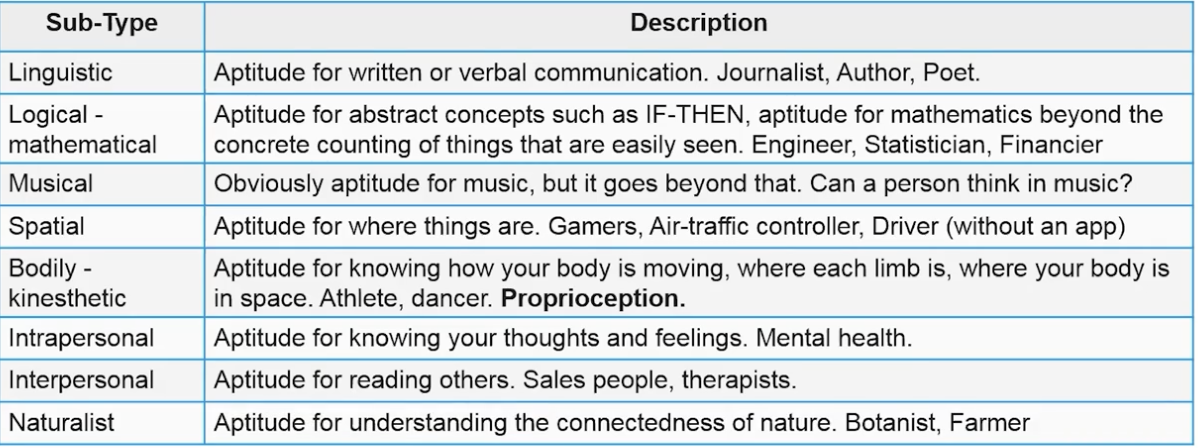
Charles Spearman (1863-1945) - believed we does actually have one general intelligence level
- called it g for general mental ability
- used something called factor analysis
- a statistical procedure that identifies factors, or clusters of related items, that seem to define a common ability
- factors that are similar occur together and can be then grouped into 1 thing
- say we have specific mental abilities that fall out of g called s
- two-factor theory general and specific
Robert Sternberg (1949-) - triarchic theory of intelligence
- theory differs from traditional psychometric tests because it realizes intelligence does not exist in a test
- it is applied in the environment the person lives in
- tries to reflect how a person interacts with their environment
- 3 categories

A real intelligence needs at least 3 traits
Standardization - against what is an individual score compared
- starts with giving many sample pretests to many people before test is actually administered as official test
- the answer we see will fall into pattern
- few people get most ? wrong
Reliability - are stable over time
- if you take an intelligence test and get a really high score and then take a different version of the same test to avoid bias and get a low score test is not reliable
- retesting effect
- a good test must correlate with another version of the test to be reliable
- split in half method helps ensure testing correlation
- if 1/2 better than other show 1 side is easier
- so higher correlation = higher reliability
Validity - the most important issue in test formation just because test it reliable does NOT mean valid
i have a bathroom scale getting same weight but clothes getting small so broken scale
- so it is reliable but not valid
means that the test measured what it was intended to measure
\

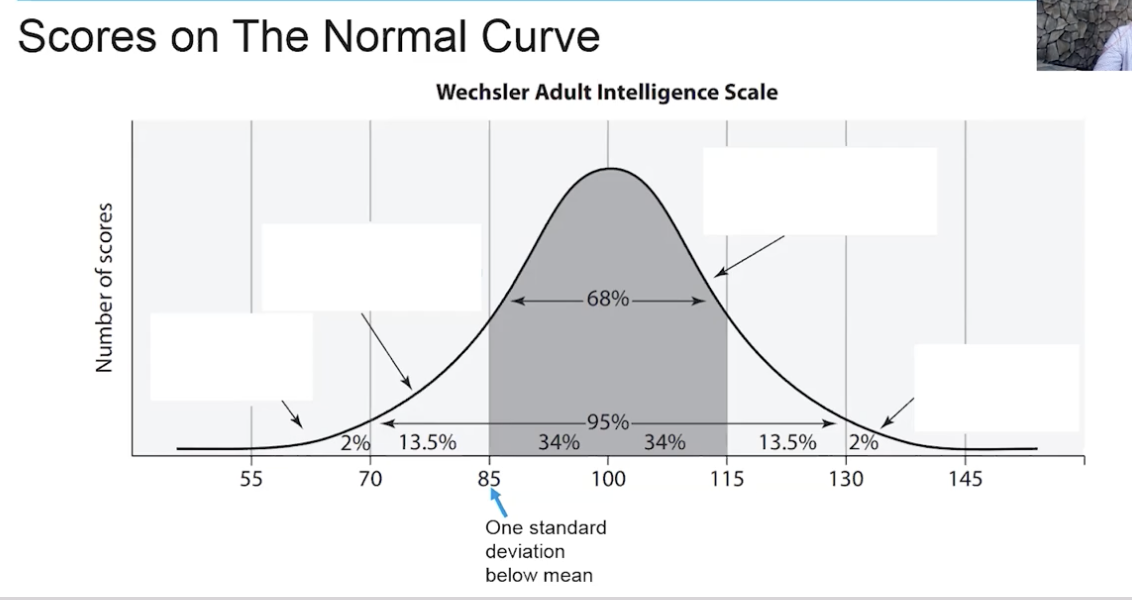 68% within 1 standard deviation and 95% within 2 very rare to find 3 standard deviation
68% within 1 standard deviation and 95% within 2 very rare to find 3 standard deviation
Language
William James functionalism
it acts like a structure or scaffolding for thoughts to grow
Secondary Language Acquisition - it purposeful conscious activity to try to encode rules conventions and patterns of the second language
- is it hard to do
Primary language acquisition - is an unconscious process
- infants are not conscious aware of learning how to speak
- they learn through complex neural process
Noam Chomsky said humans will learn or even develop own language
- infants are neurologically pre wired to learn language
- deaf babies babble sounds they have never heard
- language acquisition device - this process
- is considered a nativist/nature
Edward Sapir theorized that the language we are born into shapes or determines what kinds of thoughts we think in an unalterable way
- linguistic determinism - the language we are born in determines the way we think
- we can not think certain thought due to the way we raised ex:wabi sabi means roughly finding beauty in imperfections
Linguistic relativism - suggests that thoughts can be altered if a person not only learns to speak a new language but if they can think in that new language
- sapir-whorf hypothesis is linguistic determinism/relativism
Stages of language acquisition
Unit 6
Prenatal Development
Three stages of prenatal development are germinal, embryonic, and fetal
- embryonic and fetal most vulnerable to teratogens
- especially with a strong correlation between smoking/alcohol and birth defects
Zygote - fertilized egg
- 2 sets of 23 chromosome and 2 sex chromosome
- father delivers sex of baby XX girl XY boy
- least vulnerable to environmental influences
- genetic issues can happen
- phenylketonuria PKU - inability to produce enzymes to digest proteins inherited autosomal recessive and neurological impairment
- down syndrome trisomy 21 - not usually inherited and likely causes by gene copying error results in physical growth delay and intellectual disabilities
Placenta - amniotic fluid with umbilical cord
- everything mother eat, breathes, or drinks the baby gets
- environmental influences teratogens
- teratogens - any environmental agent that can reach the embryo or fetus during prenatal development and cause hard
- ex: alcohol = fetal alcohol syndrome, increase alcohol abuse later, neurological and physical impairments and tobacco = cleft palate low birth weight
Embryo - is provided nourishment and oxygen by the placenta about 2 weeks
- organs begin to form, heart begins to beat, central nervous system begins to develop, neural tube closes
Fetus - nine weeks - birth everything will further develop
- sex organs differentiate, toes/fingers grow, hearing develops, lungs develop, brain undergoes rapid growth, bones/muscle develop, and everything to survive
Social Development
Erik Erikson - 1902 and met anna freud and identified 8 psychosocial stages everyone goes through in life with conflicts that result in person either from a strength or weakness
Trust vs Mistrust Infancy - 18 month
- trust caregiver to take care of their needs
- result in believing world is scary place
- basic sense of trust
Autonomy vs Shame/Doubt early childhood
- take care of their own needs such as going to the bathroom
- they will feel independent and confidence
- or feel shameful from failing and from their parents
Initiative vs Guilt play age/preschool
- assert power and control over themselves and social interactions
- choose what they want to wear aka I do it stage
- child who given free choices gain initiative or else they will feel guilt
Industry vs Inferiority school age
- productive hard working making friends good work in school all leads to industry
- otherwise will feel inferiority especially when comparing
- teachers and peers are important in this stage
Mary Ainsworth focused on attachment styles through strange situation test
- tested how babies respond to the temporary absence of their mothers
- test steps: mother, baby, stranger in room → mother leaves baby with stranger → mom returns stranger leaves → mother leaves baby alone → stranger returns > mother returns and stranger leaves
- results of observation led to classification of 3 attachment styles: secure, resistant, avoidant
- secure - upset when mother left and uncomfortable without but comfortable with
- resistant - insecure resist contact and distress without mother
- avoidant - little to no emotion
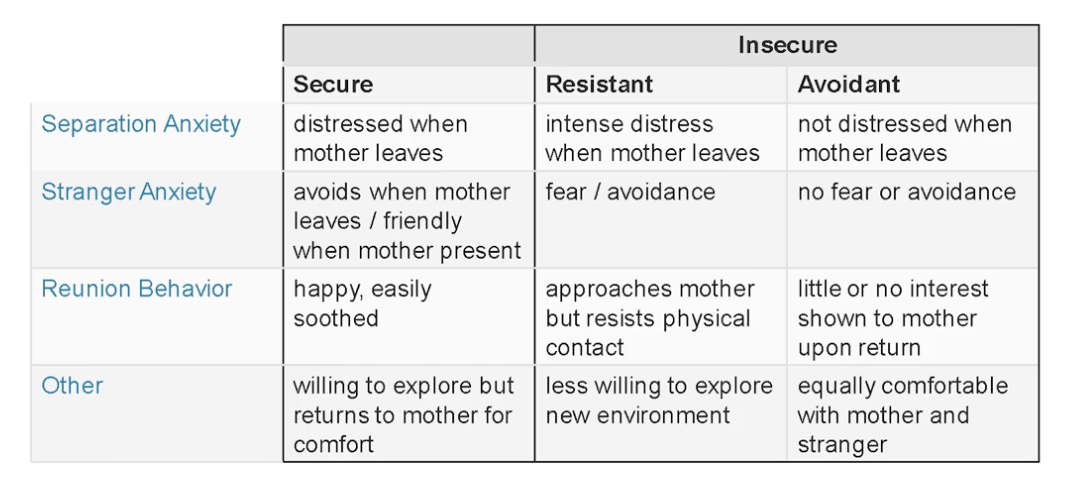
Diana Baumrind developed parenting styles
Parenting styles are determined by levels of warmth and demand 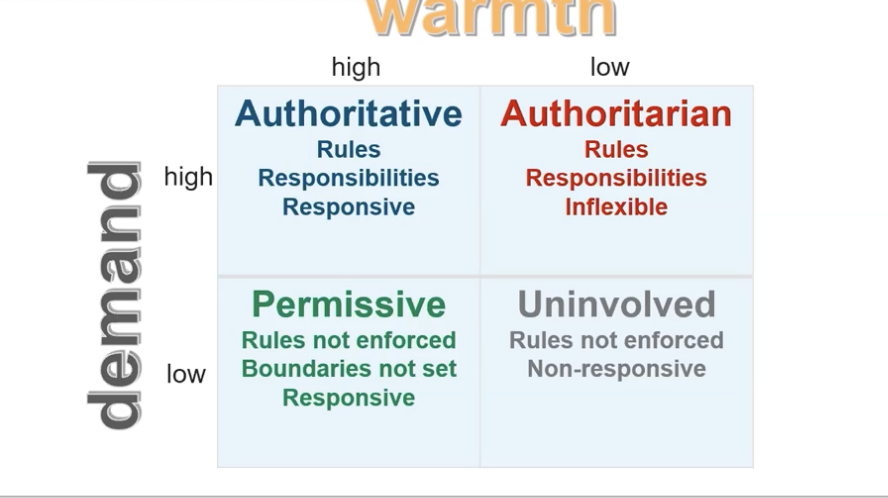
- parenting styles outcomes in kids
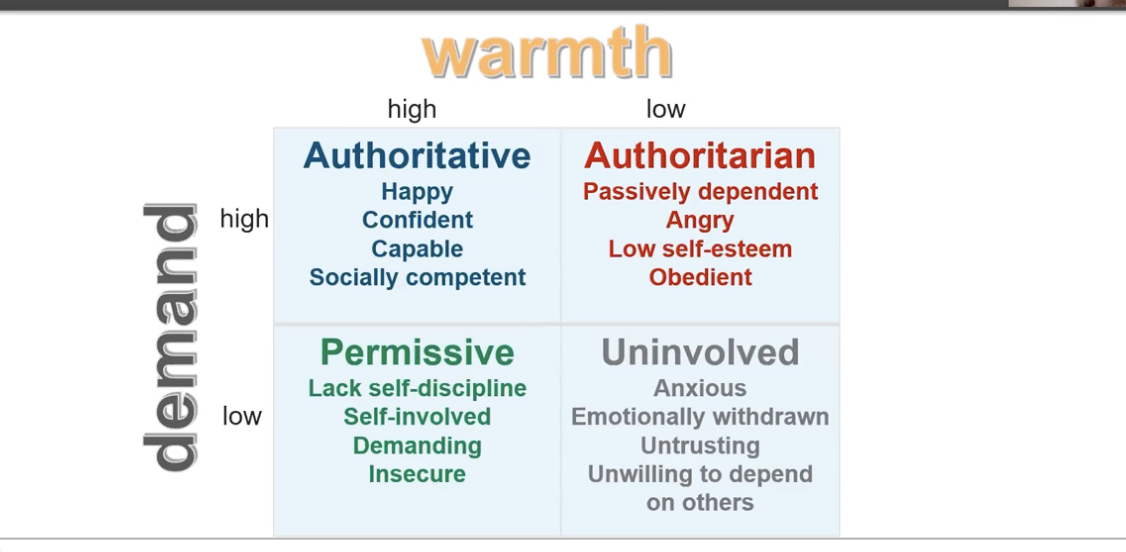
- parents can have different styles
- parenting styles have great effect on child’s social development
- authoritarian parent impact child’s initiative vs guilt usually taking away sense of power/control
- permissive parents children will most likely not follow rules and be selfish
- uninvolved parents can result in child feeling untrusting
- authoritative parents correlated with positive social outcomes
Cognitive Development
Schema - a mental representation of what we know
- this is how children build their understanding of the world
- ex: 4 legs = dog
Assimilation - using predetermined schemas to interpret a stimulus
- ex: call a cat a dog because it has 4 legs
Accomodation - altering these representation to incorporate new information
- ex: parent say cat meow and dogs bark so now child creates 2 different schemas
A child will alter accommodate their existing schema for dogs and create a new one for cats which is also accommodation
We are constantly judging and interpreting our environment using existing schemas
- stimulus generalization - is actually saying cat is dog because it has 4 legs
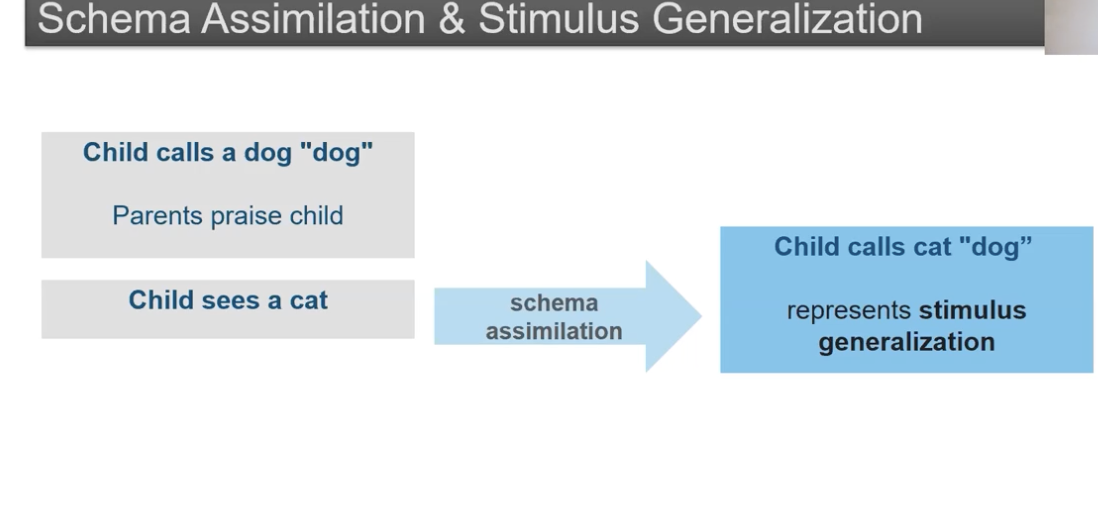
When discrepancies between what we already know and what we discover appear we must accommodate our schemas
Piaget Stages
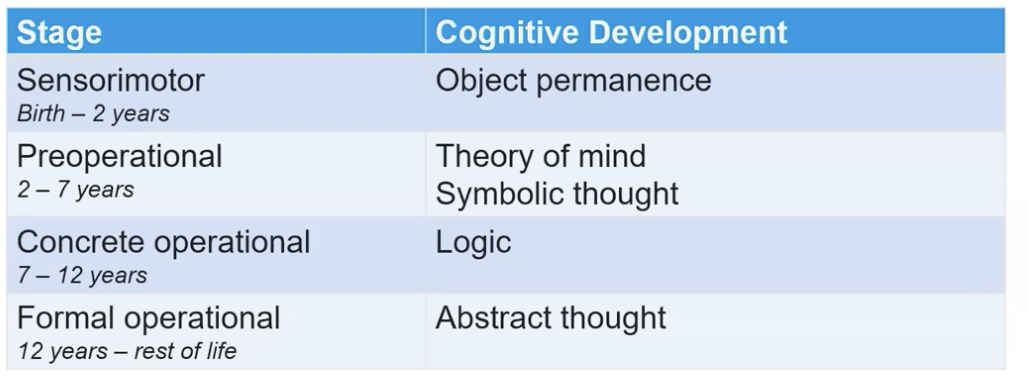
- criticism of theory = ages may be underestimated
Preoperational stage
- egocentrism - inability to see another’s point of view
- eventually will develop theory of mind
- theory of mind - a sense of what others are thinking or feeling
- ex: empathy when child falls off playground
- speak but not reading or writing in this stage
- an object or idea has a singular meaning
- symbolic thought - objects and ideas can represent stand-ins aka pretend play
- able to string together represent words
Concrete operational stage
- logical thinking
- reversibility - numbers/objects can be changes and returned to their original condition
- conservation - objects maintain the same properties in spite of their appearances
- classification - ability to group objects based on multiple properties
- seriation - arranging objects in order based on a specific classification
Adolescent and Adulthood Development
Identity vs role confusion Adolescence
- you may end up with confused
- erikson believed identity is found by conflict
James Marcia - believed identity is found by identity crisis
not uniform across all development aspects like work religion and politics
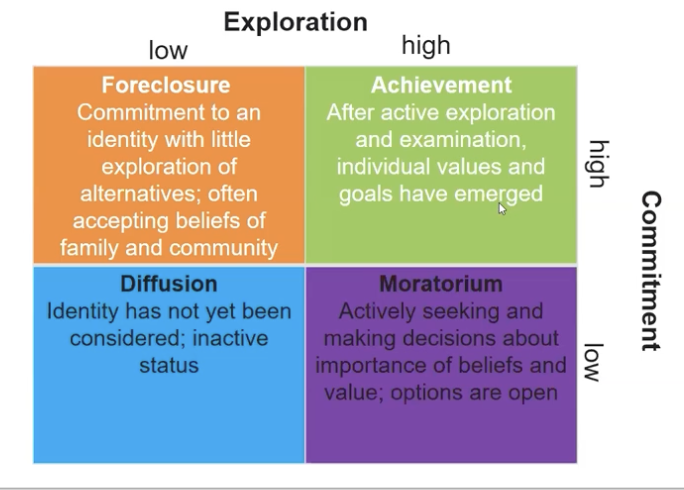
no order of process but also can enter cycle multiple times
Piaget on adolescence
- Formal operational abstract - to think hypothetically and predict things
- able to imagine how others view them
- can lead to egocentrism in 2 ways
- imaginary audience - an adolescent tendency to believe that others are watching and evaluating them
- ex: self conscious behavior
- personal fable - an adolescent belief that they are special and unique, none of life’s difficulties or problems will affect them regardless of their behavior
- ex: risk taking behavior
Adolescent risk taking behavior
- biological - prefrontal cortex unable to mediate actions of limbic system
- psychological - personal fable
- social - influence of peers
Aging and Biopsychological changes
- Brain - regional loss of volume frontal lobe cerebellum, telomeres shorten, decreased plasticity
- risk of dementia - decreased ability to think and remember
- Memory - procedural and semantic stable but decline in working memory, fluid intelligence
- declining fluid intelligence
- Other changes - vision - presbyopia, declining sex hormone levels, loss of muscle mass
To lessen effects of aging exercise, healthy diet, and new experiences
Erikson’s social development
Intimacy vs Isolation - Early adulthood
- do they establish maintain intimate relation
Generativity vs Stagnation - Middle Adulthood
- by having children or giving back
Ego Integrity vs Despair - Late adulthood
- what they accomplished and relationship
Moral Development and Gender Sexual Orientation
Lawrence Kohlberg - longitudinal study from 1958 - 1978 with population of males ages 10-16 at start and sample 72 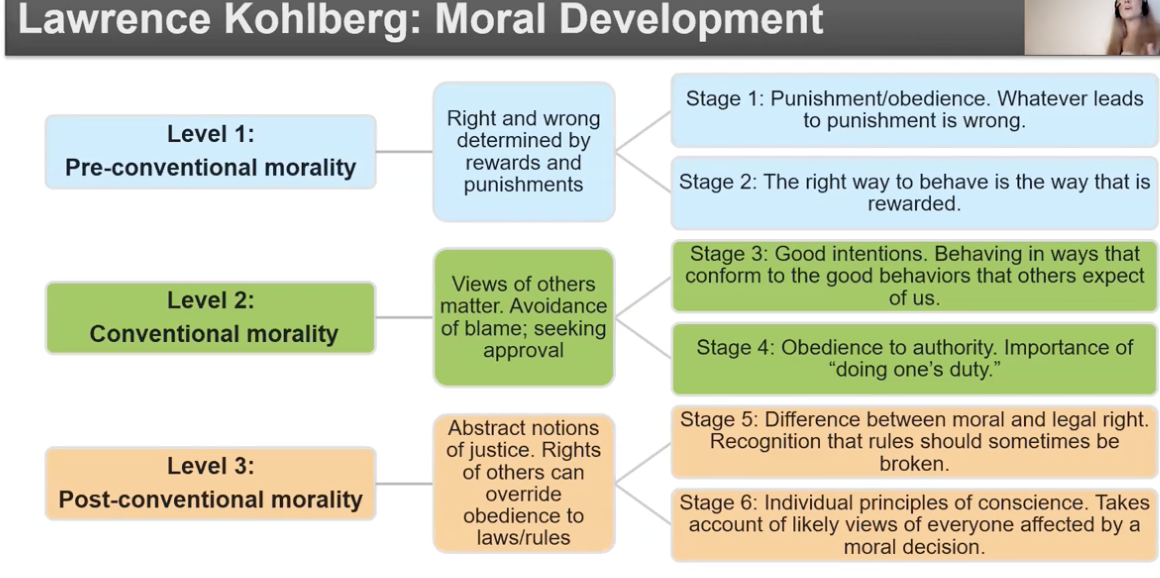
- conclusion - identified 3 distinct levels or morality and 2 stages in each level
- progression through stages was consistent among sample
- speed of progression based upon socioeconomic class
- Stage 1 really based on what will happen to you
- Stage 2 is based on social approval
- Stage 3 is based on harm that is being done, respect to peoples, and help people health
Kohlberg Internal Validity
- construct validity - was it accurate way to test morality
- predictive validity - did test questions predict principled moral behavior
- demand characteristics - do they respond in a way they think researchers want them to
- social desirability bias - they answer to impress and seem more moral
Carol Gilligan
- critics of kohlberg
- tested if generalization was possible
- so tested men and women
- it was not generalized to women
- Kohlberg was logic, social organization, justice
- Gilligan was interpersonal relationships
Gender identity is a complex concept that is influenced by biological, psychological, and social factors
Gender roles - expected behaviors for male and females based on culture
Gender stereotypes - a schema children develop about the behavior of people based on their gender
- come from our understanding of gender roles and prior experience
Gender schema theory - children actively form mental categories/schemas for masculinity and femininity recognize their own gender role and select activities that match that role
- could result in pressure to change
Unit 7
Motivation Theories
Motivation - is the need or desire that energizes and directs behavior toward a goal
Primary needs - innate/unlearned biological based such as hunger, thirst, warmth
Secondary needs - psychological such as social approval, belongingness, love
What motivates us?
- Run because reduce stress, been sitting all day, want to look good
- Skydive because friends are doing, win a bet, adrenaline rush
- Eat because hungry, taste good, bored
Evolutionary Theory - humans behave in ways to optimize their genetic fitness.
Drive reduction theory - state of tension or arousal caused by biological/physiological need this unpleasant state is motivating us to engage in drive reducing behavior
- created by Clark Hull a behaviorist
- physiological needs that push us towards behaviors
Drive reducing behaviors - we are motivated to engage in behaviors that reduce drives in order to return our body to homeostasis
Examples of drive reduction theory
Connect drive reduction theory to Thorndike’s law of effect (behaviorism)
- Thorndike LOE says that any behavior that leads to a desirable outcome will be repeated
- if homeostasis is achieved by eating, drinking, exercising, or taking a drug, that behavior will be repeated
Incentive Theory - we are pulled by incentive to behave in a certain manner
- motivation comes from incentives that promise some valued outcome/reward or avoidance of an aversive stimulus/punishment
- incentives are either positive or negative external stimuli that motivates and pull us toward a behavior

Connection of Incentive theory and Thorndike’s LOE behaviorism and biological perspectives
- LOE states that any behavior that leads to desirable outcome will be repeated
- biologically the neurotransmitter dopamine is released in a neural reward circuit when we feel pleasure we are motivated then to engage in the behavior that brought us pleasure
Incentive theory is based on both intrinsic and extrinsic motivation
Overjustification effect - occurs when intrinsic is overcame by extrinsic
lepper, greene, and nisbett studied this through giving kids markers to play with and a reward or not
result in kids with no reward to play with it normally the rest played shorter and lost interest
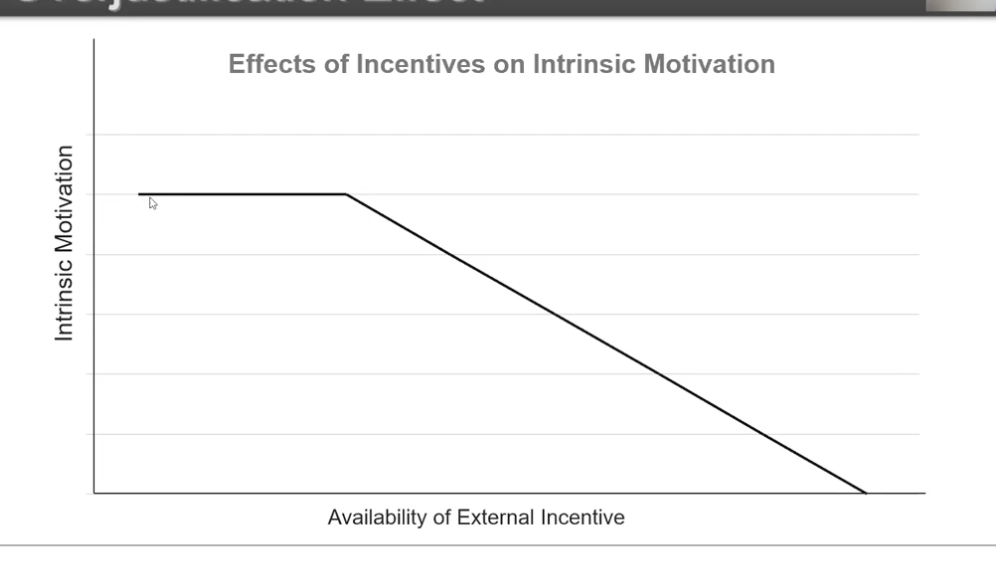
Arousal Theory - people are motivated to take actions to either increase or decrease their arousal levels in order to achieve and maintain a personal optimum level of arousal
- physiological/biological - high optimum level = spend weekends skydiving, rock climbing, or low optimum level = what sweat
- emotion - high optimum level = gossip, create drama, fall in love or low optimum level = im staying out of this
- intellectual - high optimum level = double major in biology and math or low optimum level = major? can figure that out later
Yerkes-Dodson law - the relationship between arousal and performance
- hypothesis - too much or little arousal will impede performance
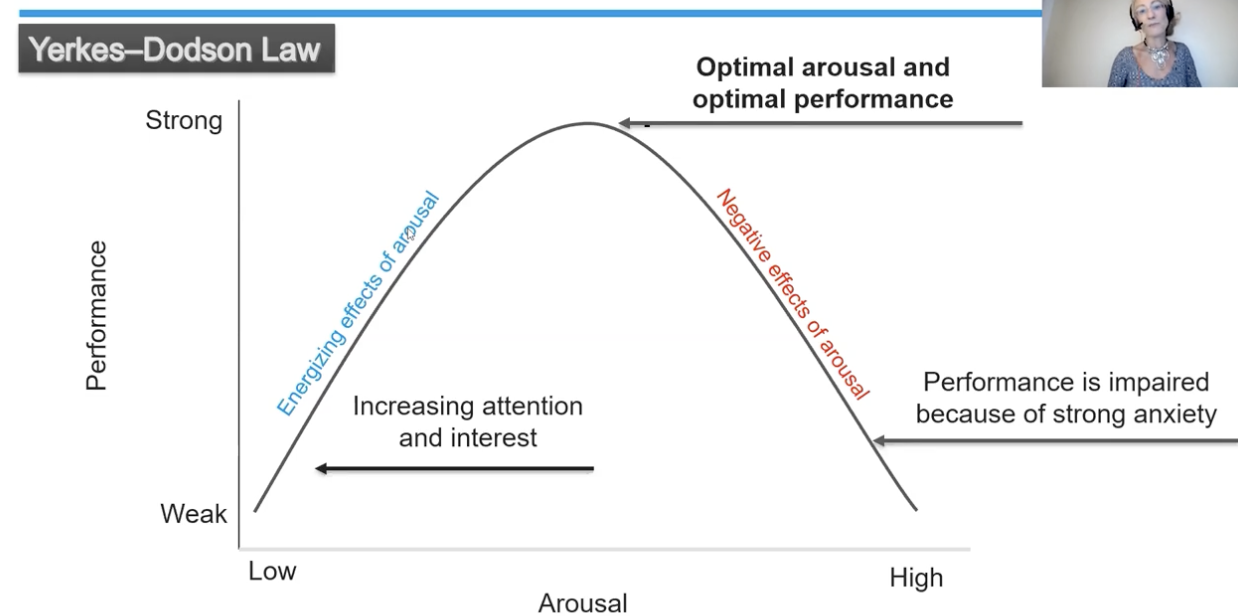
- too little arousal and motivation to perform is not there
- tasks that require stamina or persistence can withstand higher levels of arousal before performance impaired
- too much arousal and anxiety will hurt performance
- difficult or new tasks require lower levels of arousal before performance is impaired
Hierarchy theory - Maslow's hierarchy of needs is a theory of motivation which states that five categories of human needs dictate an individual's behavior. Those needs are physiological needs, safety needs, love and belonging needs, esteem needs, and self-actualization needs
a model of either within-person dynamics or individual differences in personality in which some psychological constructs are viewed as high-level variables that organize or govern the functioning of other lower level variables.
Specific Motivation Topics
Hunger is physiological drive and we are motivated to reduce this drive
Maslow’s motivation to fulfill basic physical needs
Pulled by promise of reward by eating
Hunger and eating behaviors the biopsychosocial approach
- biological - hypothalamic activity and hormones secreted glucose level
- when you eat glucose is raised and hunger is diminished then insulin is secreted by the pancreas which takes and packs glucose away this and time causes you to be hungry and your glucose is lowered and hunger is increase
- psychological - anticipated pleasure/reward of eating, mood
- social cultural - presence of others and serving portions
Hypothalamus 2 centers for hunger and satiety
- lateral - when stimulates promotes eating behavior through the release of the hormone orexin
- lATEral increases hunger
- Ventromedial - when stimulated promotes satiety or fullness
Hormones of hunger 
- leptin - secreted by fat tissue and will stimulate fullness/satiety/ventromedial
- ghrelin - stomach secretes this because hungry stimulate lateral
- orexin - stimulates lateral
- insulin - secreted in response to high glucose level/satiety center
- PYY - secreted in digestive tract when full
Motivational conflict
Approach-Approach - arises when choosing between 2 desirable but mutually exclusive options it is a win win
- convient and low conflict
Avoidance-Avoidance - occurs choosing between 2 undesirable but mutually exclusive options it is a no win situation and pick between the lesser of 2 evils
- tend to procrastinate and hoping for a new alternative option and high conflict
Approach-Avoidance - occurs when a single/one event or goal has both desirable and undesirable consequences
- avoid decisions until it has to be made and major source on conflict
Double Approach-Avoidance - occurs when you choose between 2 options that have both desirable and undesirable consequences and are mutually exclusive
- highest level of conflict
Theories of Emotions
Experiencing emotion
- ex: wake up in middle of night to loud sound you experience physiologically and emotionally
James-Lange J-L backward alphabet S-P-E
- Stimulus (autonomic nervous system) → Physiological Arousal (endocrine and limbic system) → Emotional experience
- emotion occurs as result of physiological reaction to event
- ex: noise → heart pounds → fear
- weakness of theory - relies on the premise that every emotion is accompanied by a unique pattern of physiological arousal
Schachter-Singer 2 factor theory
- stimulus → physiological arousal
- a cognitive appraisal of the arousal precedes the emotional experience
- ex: noise → heart pounding → home alone (what do i attribute this arousal to) → fear
- your emotional expeircnee is dependent on your cogntive appraisal/interpretation of experience
- weakness of theory - some emotions seem automatic like fear resulting in no appraisal
Cannon-Bard theory of emotion (happens independent and same and C-B very close letters same time)
- stimulus → physiological arousal + emotional experience
- stimulus → autonomic nervous system + amygdala
- the physiological arousal and the emotional experience occur simultaneously and independently in the thalamus
- ex: noise → heart pounding + fear
- weakness - doesn’t factor in new situations where we may be unclear as to what we feel like ambiguous stimulus
Lazarus theory of emotion (Lazarus the loser loner because copied C-Bd)
- stimulus → cognitive appraisal → physiological arousal + emotional experience
- a cognitive appraisal of the stimulus precedes both the physiological arousal and the emotional experience which occur simultaneously
- ex: noise → i am home alone → heart pounding + fear
- weakness - do we always think before we feel are there some emotions that are immediate
Some emotions seem automatic like fear, anger, surprise
- emotions are quick for survival = evolutionary thinking
- emotions require cognitive appraisal = schachter-singer and lazarus
High road to emotion - indicates there is a thought process going on such as cognitive appraisal
- lazarus and schachter-singer
Low road to emotion - some emotions are automatic so no cognitive appraisal needed
- Zajonc-LeDoux Theory
- stimulus → emotional experience
2 routes to emotion
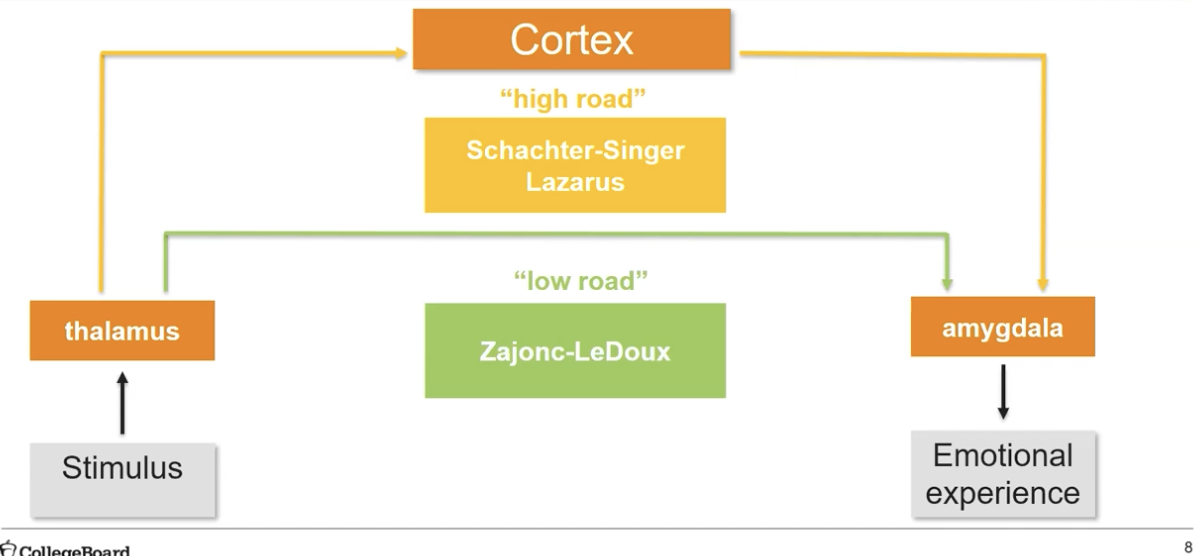
low road immediate thalamus → amygdala
high road thalamus → cortex → amygdala
high road emotions = guilt, happiness, love
low road emotion = fear, anger
Theories of emotion can coexist
Stress
Stress - is a condition in which the human system responds to changes in its normal balanced state
- upsetting homeostasis
Homeostasis - steady state within the body
Stressor - anything that is perceived as challenging, threatening, or demanding
Adaptation - change in response to a stressor
Eustress - stress interpreted as beneficial
Distress - stress interpreted as detrimental 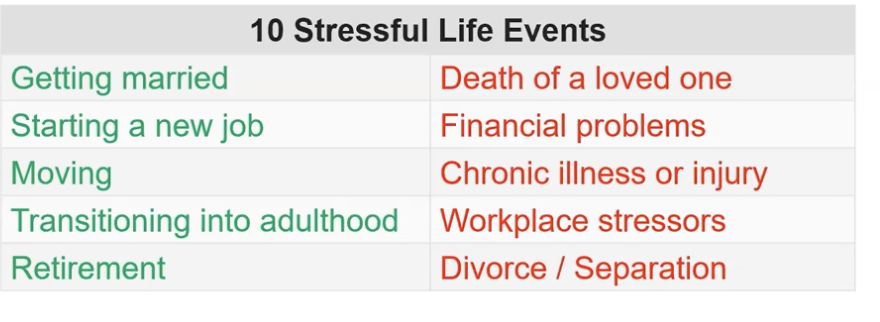
Hans Selye’s General Adaptation Syndrome
- explanation of reaction to stress
- alarm reaction - stressor upsets homeostasis
- resistance - body fights back by adjusting to the stressor
- exhaustion - body no longer able to resist the stressor
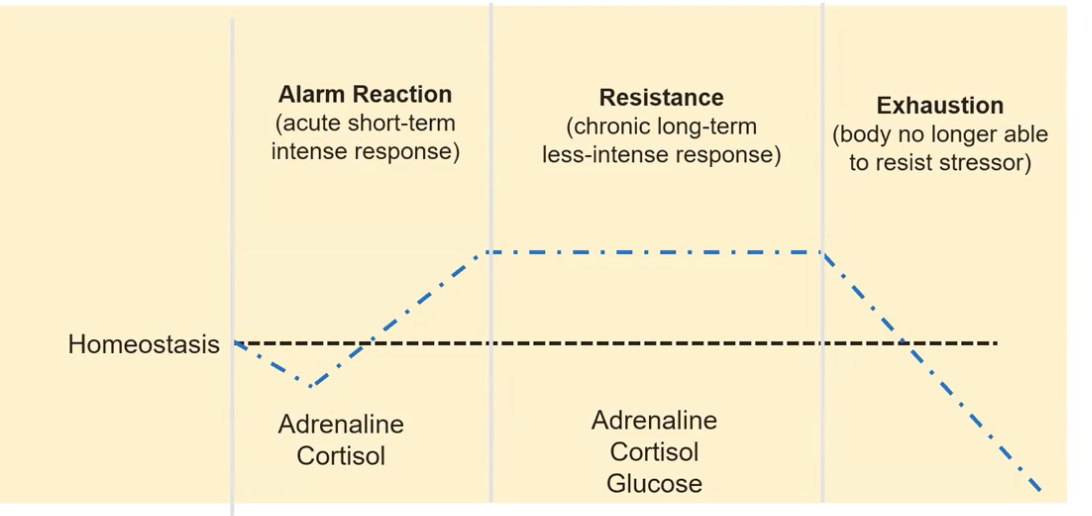
Personality
Personality - the characteristic pattern of a person’s thinking, feeling and acting
Nature belief - our genetics determine our behavior personality fixed at birth
Nurture belief - our environment and upbringing combined w experiences determine our behavior personality is nurtured 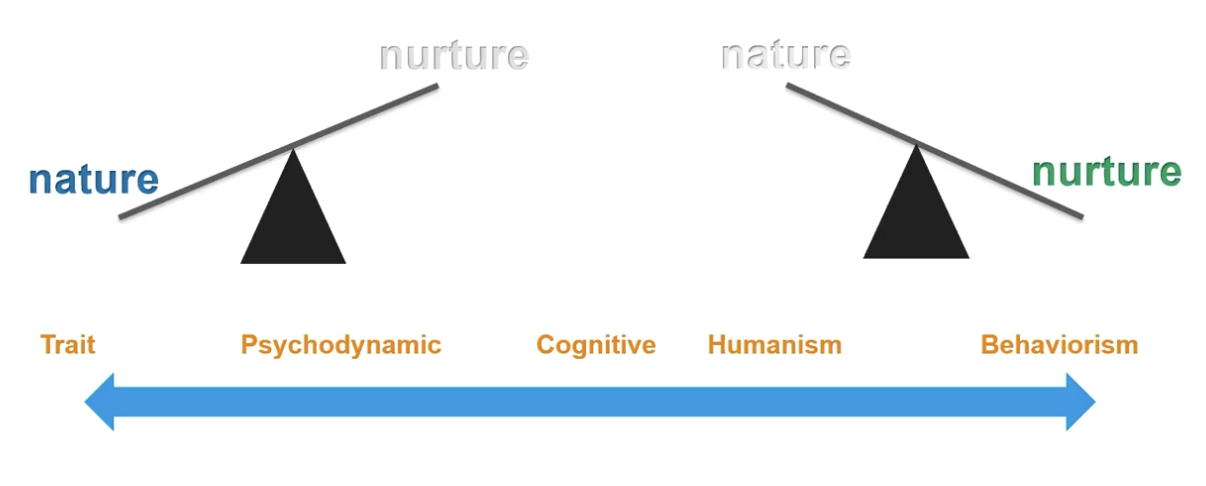
Heritability - indicates the variability in the trait in a population that is due to genetic differences among people
- estimated from twin studies
- a measurement of how much the difference/variations in people’s DNA can explain the difference/variations in their traits
- 0 genetic explain nothing about this trait
- 1 genetics explain everything about this trait
- studies often use assesments that can be unrelaible and not valid
- ex:

Personality is interaction of nature and nurture
Psychoanalytic Theory of Personality
Freud 1897 developed theory about experiences and patients
- we have psychic energy and this must be redirected during social development
- aggressive and sexual impulse fight to come out and must be restrained
- personality can be divided in 3 structures
- Id - primal, pleasure seeking portion that is almost all unconscious it want what it wants it now and operates on immediate gratification
- Superego - is the conscience it uses socialization and guilt to restrain the id mostly unconsciously
- Ego - conscious portion it listens to both id and superego and operate in reality and the ego function on delayed gratification
- These structure work together to dictate what we do
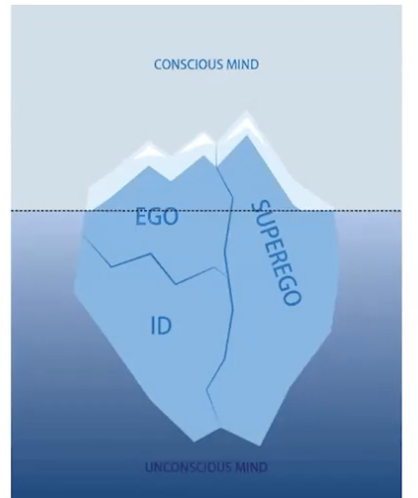
Development of personality
- personality structure develop over time as we progress through 5 stages
- each stage a conflict needs to be resolved
- if resolved normal
- if unresolved fixation can occur and last into adulthood
1st stage - Oral stage
- ranges from birth - 18 months and involves infants taking pleasure from oral stimulation
- sucking and chewing
- fixation could be chewing gum a lot
2nd stage - Anal Stage
- from 18-3 children take pleasure in learning to control bowel movements
- proud to control this uncontrollable thing
3rd stage - Phallic stage
- 3-6 children begin seeking genital stimulation and beginning sexual identification as male or female by observing parents
- starting to see yourself as a male or female
4th stage - Latency stage
- 6-puberty fixations and sexual feelings remain hidden
- nothing new or major arising
5th Stage - Genital stage
- onset of puberty sexual pleasure now comes from actual sexual behavior intercourse/masterbation
Learning what should do, what to do, and what is allowed and all this happens unconsciously
Carl Jung added idea of collective unconscious filled with archetypes
- universal types of thoughts
- innate ideas
Neo-Freudians
Alfred Adler - offered concept of the inferiority complex arguing that we constantly strive for feelings of superiority
- try to grow as people by building ourselved up or tear people down
Karen Horney differed from freud in terms of her overall view of women and by offering that environment and social situations might be causal factors in and of just biological and instinctual drives. proposed that relationships greatly shape your personality
Psychodynamic theory - modernized psychoanalytic with more conscious factors
- still plays significant role in therapeutic process today so ideas originate with freud still continue in a modified form
Defense mechanisms - how ego protects itself from demands of id and superego
- unconscious in nature and we cannot easily stop ourselves from doing them
- they protect us from anxiety
- ex:

Behaviorism and Social Cognitive
Behaviorism - only behavior is observable and abled to be studied
- proposes that personality is a function of the environment
- they are internal factors and they are in a black box
- it is predictable based on history of reinforcements and punishments
- inconsistencies in personality/behavior are due to the situation not internal factors
- comes from BF Skinner
Social cognitive - proposes that personality is due to combination of environmental conditions, behavior, and cognitive factors
- opening black box and investigating what is there
- theorists like julian rotter and albert bandura expanded on ideas of behaviorism and introduced new concepts
Bandura famous Bobo doll study
- imitation not always flattering
Rotter’s expectancy theory - we learn what to expect in different situation
- behavior determined by environment AND expectations and how much we care about outcome
- your belief in your own ability to affect the outcome is referred to as locus of control
- internal locus of control - high expectation of being able to exert control
- external locus of control - belief the outcome is determined by factors outside of your control
Bandura social learning theory - personality is learned in social situations
- 3 main components of theory
- observational learning - is when you see something modeled and then do it
- self-efficacy - is your own belief in your ability to be successful or not at a specific task
- reciprocal determinism - is the interaction o your mental stage, your behavior, and the environment and all can affect the others
Humanist theory focus on the positive
- people want to improve and grow as individuals
- we want to reach our potential aka self-actualization
- our self-conpt dictates how we see ourselves currently and where we want to see ourselve later
Carl Rogers and the self-concept
- we crave approval from others aka positive regard
- when we receive positive regard and it agrees with own self-evaluations we are in CONGRUENCY and this becomes part of our self-concept
- if our self-evaluations and others’ views are not the same we experience INCONGRUENCY and anxiety or depression can result
- Seek approval → compare to own sense of self -? self concept
Abraham Maslow and the hierarchy of needs
- very significant theory in psychology
- everyone wants to improve basic human nature
- but we have other needs that take precednece
- reaching our potential must take a backseat to other things

- proposing that explains the growth and change of personality
Trait theories
3 basic assumptions of trait theories
- Personality traits are relatively stable in individuals and therefore predictable
- Traits are relatively stable across situations
- everyone is different in how much of one trait and how much of another they have leading to infinite variations in overall personality while being compromised of same basic trait
Gordon Allport - analyzed the dictionary to idenitfy words that describe human behavior
- detemined that perosnlity could be described in 7 or fewer terms most of time
- personality consists of cardinal traits (rarely and they are so strong that only thing comes to mind when you try to define them), central traits, and secondary traits
Raymond Cattell - used factor analysis clustering traits that are typically together to identify personlity factors or dimensions
- developed a test to assess them
- the factors were bipolar like shy vs blod
- the degree to which a person scires on 1 sideor other pf each factors forms their unique personlity
Hans Eysenck - used factor analysis but ended up with only 2 dimensions
- emotionality vs stability
- extraversion vs introversion
- proposed that biological causes were behind the different levels of each factors for different people
- ex: people with greater emotional stability have nervous system that are more resistant to stress
Paul Costa and Robert McCrae - the big 5 model
- based on their own factor analysis and many others of personality traits/factors they identified 5 dimension appear across the board
- OCEAN or CANOE
- Openness vs Close Minded
- Conscientiousness vs Unconscientiousness
- Extraversion vs Introvert
- Agreeableness vs disagreeableness
- Neuroticism vs emotional stability
Personality theory in chart form
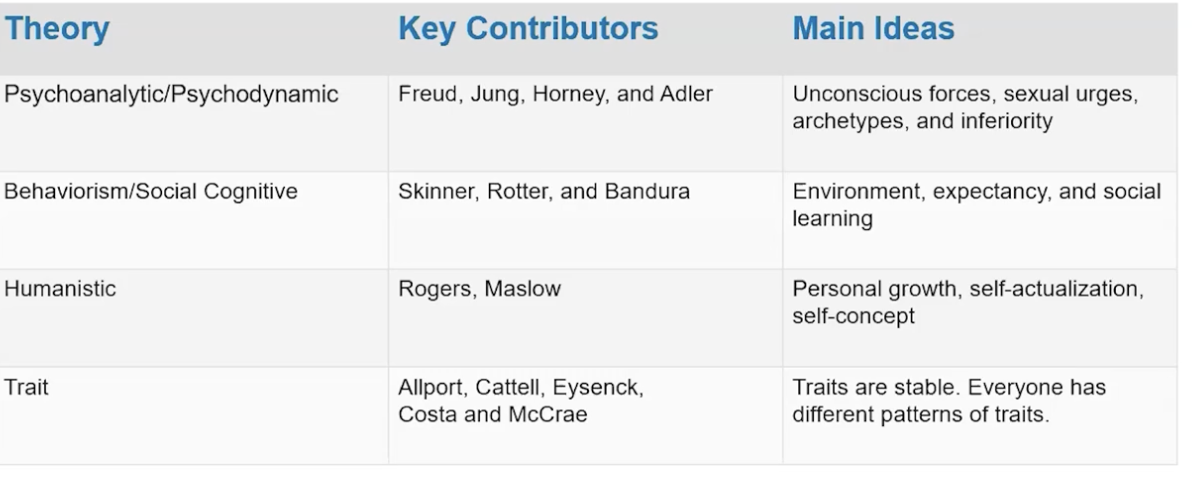
Measuring personality
Personality assessment is mostly about traits and characteristics
4 main sources of information to describe someone’s personality
- Life outcomes - education level, income, marital status
- Situational tests - lab measurements of reactions behavior/emotional/physiological to different types of events
- Observer rating - judgements made by those familiar with the individual
- Self-reports - responses to personality tests
2 types of personality tests
Objective personality tests - straightforward question with multiple choice
- ex: minnesota multiphasic personality inventory MMPI
- makes use of clinical scales to compare with others who displayed psychological disorders to personality characteristics
- ex: Myers-briggs personality test indicator MBTI
- categorizes people based on 4 personality dimensions
- less reliable and valid than the MMPI
- ex: neuroticism extraversion openness personality inventory NEO-PI designed to assess big 5 traits
- quite reliable and correlates well with other quality assessments
Projective personality test - ambiguous make your own
- primarily use by psychologists with psychodynamic background
- unconscious guides responses yielding insight into personality functioning in subtle and indirect ways are likely to think, feel, and act that is difficult to obtain from objective tests
- ex: Rorschach inkblot test - ask people to say what they see in a series of inkblot of images
- ex: Thematic apperception test - people are shown ambiguous images and make up stories about them
- lack validity and realiablity
Unit 9
Attribution, attitude, persuasion, conformity/obedience
If we thought about others like we think about oourselves
We treat others differently and often badly because of how we perceive them
- processing info in the mind and based on experience
Attribution theory - explain how we explain or attribute our own behaviors and the behaviors of others
Fundamental Attribution error
We attribute behavior to 2 factors situation or disposition
Situational attribution - we blame or credit. the situation with causing the behavior
- external factors
Disposition attribution - we blame or credit a relatively pernament trait of the persdon
Outgroup homogenenity - “they are like that” allows for all types of bias prejudice and discrimination
human mind is not good at gathering and processign lots of data
so we look at others with the use of heuristics
use representativeness heuristic for everyone off all races, genders, ethnicity
we use prototypes of groups to compare it to a new person we met
in-group - us
stereotype can cause us to think bad about our in-group
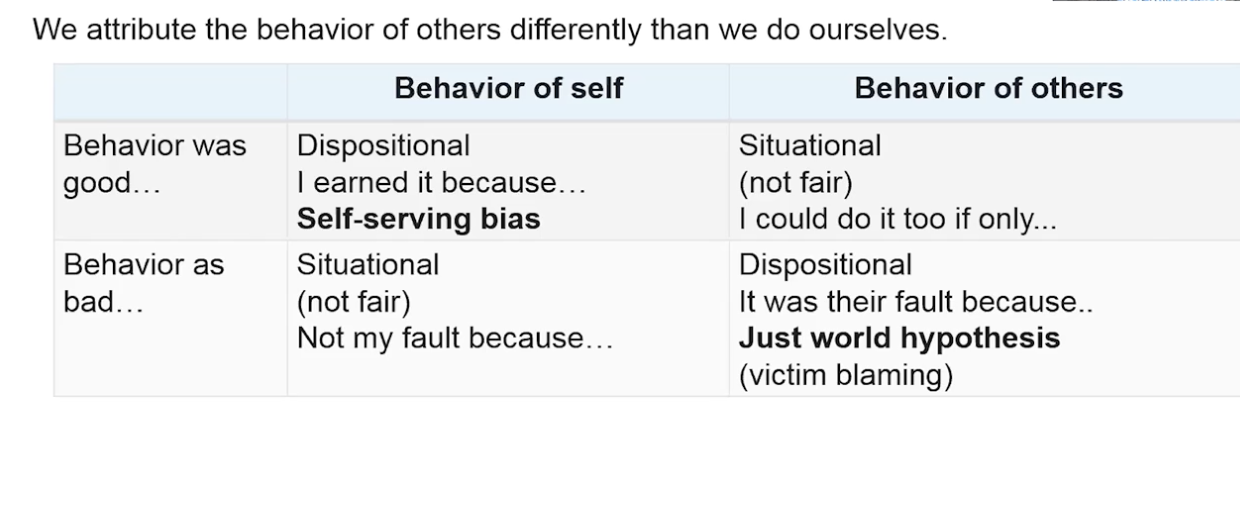
Self-serving bias - cognitive tendency to ignore information that makes us or our in-group look bad and use information that makes us look good
Just world hypothesis - the false idea that the world is fair
- we have been told if we work hard, follow the rules. and do what we are supposed to do = success
- if something works out we earn it
- we search for confirmation bias
Victim blaming - if something bad happens to someone else we might unconsciously think it is because they somehow brought it on themselves
Self-fulfilling prophecy -if you attribute your behavior to situational factors you might not try then you will not succeed and then you will blame the situation for being unfair
- won’t let us test our abilities
False consensus effect - the belief that lots of people think they way we do which allows us to keep using heuristics and tricks to continue in ways we benefit
Self-serving bias - spin ways to make us seem good
Cognitive dissonance - attitude and behaviors are in conflict with other
- fox could not change his behavior or the facts that he could not get the grapes
- so he changes his attitude of not wanting those grapes
- justifying - means you change your attitude to match your behavior or situation
- developed by Leon Festinger
- often stuck between thoughts and behaviors
Elaboration likelihood model - is a theory that is based on how much a person thinks about the relevant information in a persuasive argument
Process of forming attitude and of being persuaded are usually unconscious
Central Route to persuasion - using facts to persuade someone
- legal system, decisions involving money
- high level of elaboration
- requiring time to process and algorithm
Peripheral Route to persuasion - using emotion to persuade others
- funny commercials, political ads to make you angry
- low level of elaboration
- quick decisions making and heuristics
Psychology is not a science because of what we study it is how we study it
- gather data, process data, and turn it into info
Solomon Asch line experiment - looked at conformity
- had subjects sit among confederates/people who knew about the experiment
- subject did not know about real subject
- asked everyone about line length
- control group everyone said right answer
- experimental group confederates said wrong answer
- led to particpants answering wrong answer to
- many versions replicated
- many peeople conformed
- confounding variables - Did Asch conotrol everything?
Informational social influence - conform to what others are doing because they might have better information
Normative social influence - conform to whay others are doing to fit in because they might have higher status in a situation
Milgram Obedience - after Nazi how was this evil possible and was this evil obediencde generalizable
- experiementer was an authority figure with symbols of power
- teacher/subject was told to shock the learner/confederate when he got a wrong answer
- involved fake assignment
- each time learner got answer incorrect shock him but increase level of voltage
- subjects did not want to shock them but THEY DID often tried to resist but complied with authority figures instructions
- compliance - means behaving in a way you do not want to because you are reinforced
- more rigid than conformity
- 65% went to highest voltage
- problems - ethics even though no actual shock cognitive dissonance of teacher killing somebody due to intensity of shock
- confounding variable - consisency problems due to authority figures giving different instructions and demand characteristics - it was not real
Stanford experiment - asked for ad for volunteers to be in study and then randomly assigned them to prisoner or guard
- both conformed to their roles
- guards enjoyed being thought and making prisoners feel helpless
- prisoners conformed to role of prisoners and forgot they were participants
- some showed extreme reactions
- problems - wasn’t a experiment because not experimental group that got independent variable, no control group that got placebo, no double-blind technique and ethics
- results were not completely true and may be over exaggerated
Group Influences
Humans are social creatures and when we are physically alone we are on social media
We are still affected by influence of others
Think about things we have done or thought by yourself that you feel bad about or feel proud about
- but think about relation to others
We are never free from the influence of others
Being influenced by others is normal, common, and sometimes good
Sometimes you and we gets diffused, spread out, or disappears/diluted
Diffusion of responsibility - is a categories of social psychology concepts that occurs when people feel less of a responsibility to take the right action when other people are present
- we are less likely to be ourselves or to think ourselves as an individual
In-group/out-group bias - we like our groups more than other groups and think differently about us and them
- overlaps just world hypothesis and fundamental attribution error
- how much we are influenced by other people depends on whether we see them as an us or a them
- idea that automatic classifying people
Deindividuation - temporary loss of self awareness
Bystander effect - types of diffusion responsibility where people are less likely to offer help
Social facilitation - when group is around people are around an individual performs better
Reciprocity norm - means to give back so when person a does something for person b will do something positive back and work for negative events to
Social norms - an understanding of how people should act
Social inhibition - it is when we curb our behaviors, comments, and even personality for fear of not matching the social climate
Group polarization - group members decisions and opinions become more extreme than og
Social traps - when extreme short term competition reduces long term utility
Compete vs Cooperate
Social loafing - type of diffusion of responsibitly
- every group project has this
- the idea that someone else will take care of it
Social trap - type of diffusion of repsonsibilty
- when extreme short term competition ruins long term utility
- exact opposite of compromise
Prisoner dilemma
Conflict is inevitable but winning and losing do not have to be
- Non-Zero Sum result
- win = +1 lose =-1
- so everyone wants to win/1 and tries to force -1 = social trap
Game theory - a method of seeking non sero competition or win-win
- cognitive dissonance comes with this
Cognitve psych to explain Social psych
Social biases
bias - the predisposition of being for or ahinst that is typically considered unfair
- seen research biases hawthorne effect/being observed effect, placebo, sampling errors
- cognitive biases - confirmation bias, anchoring bias, hindsight biases
In/out group bias rules them all
- we treat in group better than out group
Relating cognitive and social psych
Consider that all social problems are because we are definign us vs them and not related us with them
Ethnocentrism - when people judge other cultures according to the preconceptions based on their own culture
- culture shapes mind so you can think of your own cultural schema when thinking about another culture
- culture based thhoughts to judge in vs out
Brain not good at proccessing lots of data
Out-group homogeneity bias - they are all like that
- mind thinks whole team is like few people you know
- usually negative
Prejudice - is unjustifiable negative attitude or stereotype of a group without having sufficient info to support such idea
- formed by bottom up thinking - had interaction and you mind take info and form conclusion
- and use top-down thinking when you see a person who fits this
- negative thoughts about in-group = cognitive dissoance
Stereotype - are generalize beliefs based on the characteristics of few group members
- representative heuristics
Discrimination - is negative behavior based on prejudice
- what you do with those thought
- usually by people who have power or money
Mere exposure effect - tendency to develop positive feeling for things after being frequently present with them
- the more you see it them more you like it
- works to increase familiarity and positive feelings towards members of outgroups or about their culture
- it has it limits like things you hate
Altruism
Aggression - is hostile behavior toward another person or their interest
Passive aggression - still aggression but aggressor is still trying to harm by indirect means
Psychology aggression approaches
Evolutionary approach - suggests that aggression is part of a natural evolution process animals and people who were more aggressive had a better chance of passing on their genes
Biochemical approach - suggests aggression is related to a feedback loop between certain brain structures via electrical and chemical reactions
- amgydala, hypothalamus, high testosteron levels, low levels of seretonin levels, traumatic brain injuries can be related to aggression
Psychodynamic approach - suggests that the feeling of aggression and how we express it are often the result of unconscious processes
Social approach - its difficult to be aggressive if you are not interacting with others
Anger, fear, frustration
- are not bad and necessary for survival
William James suggests that everything in our body serves a function including and especially with the amygdala
Positive reaction - emotion based coping then move to solution based coping reminds of internal locus
Negative reaction - emotion based coping and being stuck in the grievance reminds of external locus of control
- Scapegoating - blaming an innocent person/group for the faults of others
- the projetions of blame by scapegoatin is a form of anger or fear
- unconscious defense
Hostile aggression - is causing physical or emotional harm is the goal and emotional/hot state or crime of passion
Instrumental aggression - when aggression is a tool used to acquire what the aggressor desires and premeditated crime
Mere exposure say being near will decrease conflicrt
- but could also lead to increased hate
Working together will work > being together
- only if groups need each other to achieve goal
Superordinate goal - interdependence both groups need each other to achieve goal
- them becomes us
Robber’s cave experiment a field experiment because they were group assigning IV but not much control
- sampling errors random sample and representative sample
- could not be generalized bv 22 white, middle class christians
- Muzafer and Carolyn Sherif had 22 boys at camp and divided into 2 group and they became friends in in-group
- result is rivalries, enemies, and aggression
- then they had to achieve superordinate goal resulting in reduction of aggressive behaviors and aggressive attitudes
Altruism - best of us why do we help others when their is not to much benefit to us
- feel good/do good, feeling guilty, part of in-group, knowing how to help, perceiving them as worthy
- \n
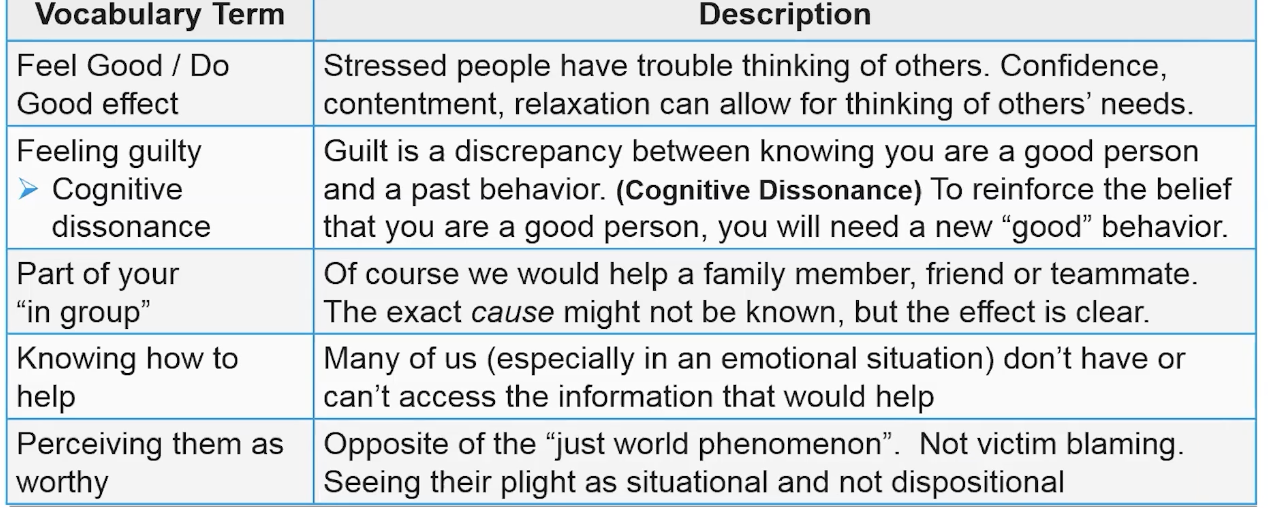
Interpersonal attraction
Are you attracted to person or idea
Attraction
- often we think in terms of romance
- it is guided by culture and media
- types
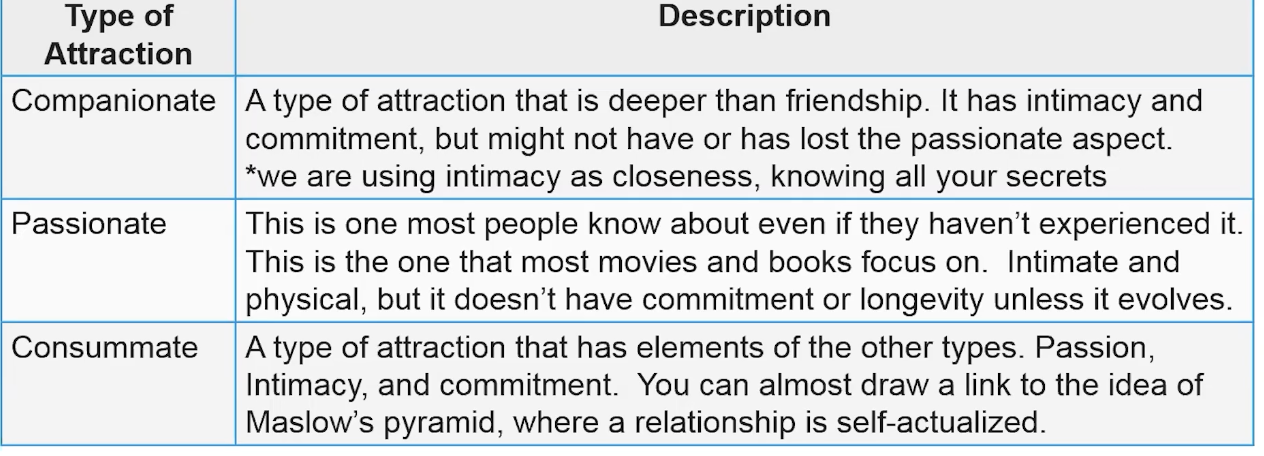
Factors that lead to attraction
Halo effect - when we think attractive people are nicer smarter than kinder than normal people
- people are not often logical
similarity - we are attracted to people who are similar to us in values interests and backgrounds
- opposites may attract but not for long
proximity - statiscally you will not like someone on a different continent
- need to be near them to like them
physical attractiveness - people are attracted to attractive people
- actually complicated
Halo effect and physical attractiveness related
Attractiveness is based on
cognitive appraisal
cultural determinations
perceptual processes (perceptual set, top-down processing, embodied cognition)
biological conditions hormones or genes
evidence that some facial features are more beautiful
Attraction = physical attraction, proximity, mere exposure effect
Friendship = physical attractiveness, proximity, similarity
